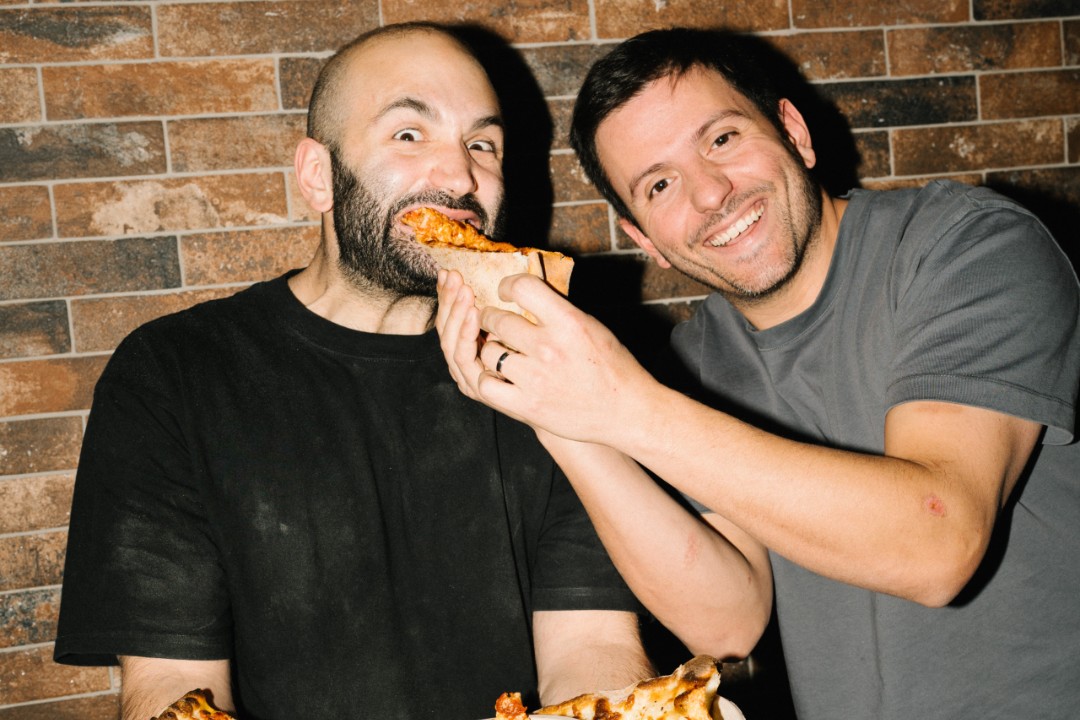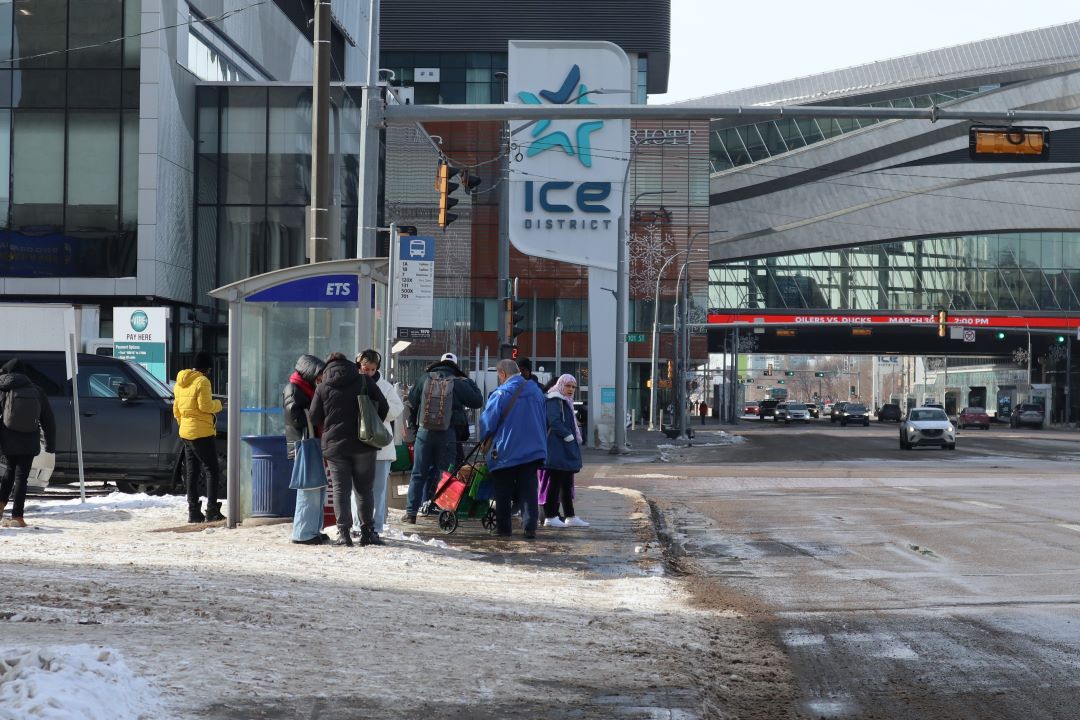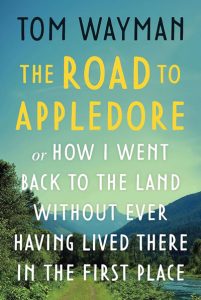 CBC Edmonton
CBC Edmonton
Oilers acquire Bruins forward Trent Frederic in 3-team trade with Devils
The defending Western Conference champion Edmonton Oilers made their first big move ahead of the NHL trade deadline by acquiring hard-nosed forward Trent Frederic from the Boston Bruins on Tuesday. ...More ...

The defending Western Conference champion Edmonton Oilers made their first big move ahead of the NHL trade deadline by acquiring hard-nosed forward Trent Frederic from the Boston Bruins on Tuesday.
4 Mar 2025 19:37:22
 CBC Edmonton
CBC Edmonton
Miyo-Kiyokâwin (Visiting in a Good Way)
Lexie Obey is a Plains Cree-Métis writer and community organizer from Piapot First Nation. She considers her connection to the land through her outdoor pursuits while hiking and trail running in Canm ...More ...
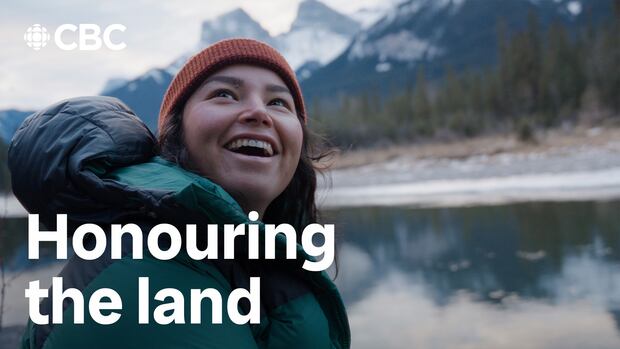
Lexie Obey is a Plains Cree-Métis writer and community organizer from Piapot First Nation. She considers her connection to the land through her outdoor pursuits while hiking and trail running in Canmore, Alta. 'Miyo-Kiyokâwin (Visiting in a Good Way)' is a short documentary produced by CBC Creator Network.
4 Mar 2025 19:06:36
 CBC Edmonton
CBC Edmonton
No charges in stabbing death of 13-year-old at Edmonton LRT station
Edmonton police said Tuesday they will not lay charges in the February death of a 13-year-old Eric Omeasoo at the MacEwan LRT station because evidence shows the stabbing was in self-defence. ...More ...

Edmonton police said Tuesday they will not lay charges in the February death of a 13-year-old Eric Omeasoo at the MacEwan LRT station because evidence shows the stabbing was in self-defence.
4 Mar 2025 18:57:48
 CBC Edmonton
CBC Edmonton
Truck hauling logging equipment damages 34th Street overpass on Sherwood Park Freeway
A tractor-trailer hauling a large piece of logging equipment struck the 34th Street overpass on the Sherwood Park Freeway late Monday, causing extensive damage that led to traffic snarls Tuesday morni ...More ...

A tractor-trailer hauling a large piece of logging equipment struck the 34th Street overpass on the Sherwood Park Freeway late Monday, causing extensive damage that led to traffic snarls Tuesday morning.
4 Mar 2025 18:37:51
 CBC Edmonton
CBC Edmonton
'No choice' but to react to U.S. tariffs, Alberta premier says in supporting federal response
Alberta Premier Danielle Smith said Tuesday she’s disappointed with U.S. President Donald Trump’s move to impose 25 per cent tariffs on Canadian goods, 10 per cent on oil and gas products. ...More ...

Alberta Premier Danielle Smith said Tuesday she’s disappointed with U.S. President Donald Trump’s move to impose 25 per cent tariffs on Canadian goods, 10 per cent on oil and gas products.
4 Mar 2025 18:03:23
 CBC Calgary
CBC Calgary
Victim beaten, drugged, dismembered, jurors hear on Day 1 of Calgary manslaughter trial
A Calgary man was restrained with duct tape, beaten, drugged, dismembered and dumped on First Nations land west of the city, jurors heard Monday as the manslaughter trial got underway for one of his a ...More ...

A Calgary man was restrained with duct tape, beaten, drugged, dismembered and dumped on First Nations land west of the city, jurors heard Monday as the manslaughter trial got underway for one of his accused killers.
4 Mar 2025 15:34:36
 CBC Calgary
CBC Calgary
Calgary police now believe 2022 suspicious death to be a homicide
The death of Rhonda Waite, 55, in the Crescent Heights neighbourhood is now believed to be a homicide after police gathered information from witnesses in the last two and a half years. ...More ...

The death of Rhonda Waite, 55, in the Crescent Heights neighbourhood is now believed to be a homicide after police gathered information from witnesses in the last two and a half years.
4 Mar 2025 14:54:24
 CBC Edmonton
CBC Edmonton
Trudeau expected to outline Canada’s response to Trump’s tariffs
Prime Minister Justin Trudeau is expected to take questions later this morning about how Canada will respond in the face of sweeping tariffs imposed by U.S. President Donald Trump. ...More ...

Prime Minister Justin Trudeau is expected to take questions later this morning about how Canada will respond in the face of sweeping tariffs imposed by U.S. President Donald Trump.
4 Mar 2025 14:00:00
 CBC Calgary
CBC Calgary
Red Deer hospital one step closer to opening new cardiac centre
After decades of advocacy and an Alberta government pledge last fall, a plan to build the $22-million facility is now in motion. ...More ...
After decades of advocacy and an Alberta government pledge last fall, a plan to build the $22-million facility is now in motion.
4 Mar 2025 13:43:25
 CBC Edmonton
CBC Edmonton
Central Alberta towns studying whether RCMP is their best policing option
Some central Alberta municipalities are looking into whether their current arrangements with the RCMP are the best policing model for them — or if there’s a different way. ...More ...

Some central Alberta municipalities are looking into whether their current arrangements with the RCMP are the best policing model for them — or if there’s a different way.
4 Mar 2025 13:00:00
 Taproot Edmonton
Taproot Edmonton
Panini's adds ghost kitchens to boost the bottom line
Tony Caruso, one of three brothers who run Panini's Italian Cucina locations in Edmonton and Sherwood Park, said the ghost kitchens he's added to several of his dine-in restaurants offer a chance to i ...More ...
Tony Caruso, one of three brothers who run Panini's Italian Cucina locations in Edmonton and Sherwood Park, said the ghost kitchens he's added to several of his dine-in restaurants offer a chance to increase revenue with limited risk.
"Say (a ghost kitchen) was to go poorly, everyone hated it — I just delete the Uber account, and it's gone," Caruso told Taproot. "Other than my pride being injured, (or) someone saying that 'These guys are dumb,' it's a pretty safe bet."
Ghost kitchens are pickup-and-delivery food concepts that run out of commercial kitchens without dine-in areas, or in the kitchens of existing restaurants that otherwise serve a separate menu to diners. The business concept has created both success and controversy, especially since the COVID-19 pandemic. Some have noted that ghost kitchens often have American parent companies and can divert customers from locally-owned restaurants.
For Caruso, the model offers an additional way to bring in revenue to keep his staff employed at his dine-in locations.
"I have like, 15, 20, employees at any given moment, and the payroll gets big sometimes. (Ghost kitchens) help offset that," he said. "From 2pm to 5pm, there's not much to do, and so you give your staff extra tasks … It's another way to keep everyone busy, and keep everybody working."
In November, Caruso opened the Michelangelo's New York Pizza ghost kitchen at Panini's newest location, at 14981 Stony Plain Road NW, which itself opened to dine-in guests roughly seven months earlier. Caruso most recently opened the grandma-style ghost kitchen, Wise Guys Square Pies, in February at Panini's Sherwood Park location, which itself opened to dine-in guests in 2022.
He also opened Rob's Famous Fried Chicken (named for his brother) last year in the same building as the Panini's restaurant on Jasper Avenue, which his parents opened in 2016.
Rob's is not a ghost kitchen as you can walk in and order food at the counter. The brothers decided to take the vacant space over near their existing Jasper location in 2024 to provide additional storage and prep space for Panini's. The property left room to offer takeout, too. "We didn't know what to do with the front half of that space," Caruso said. "That's when fried chicken came up … So that's how that started, and then that brand exploded. It still does extremely well."
Caruso said he picked both of Panini's newest locations, in part, because they were already outfitted as restaurants, saving him around $70,000 each in kitchen HVAC equipment alone.
Looking ahead, Caruso said he hopes use events to draw more people to Panini's on Stony Plain Road, such as ticketed Sunday dinners with entertainment like live pianists and opera singers.
He also suggested further change to the family business is all but inevitable. "Rob and I get bored quickly," he said. "It's like, 'OK, this feels easy. Now, what are we going to do instead?' We like feeling that pressure of the next thing — my mother-in-law says I'm addicted to it."
4 Mar 2025 13:00:00
 CBC Calgary
CBC Calgary
New housing officer to be 'face and voice' of Calgary's housing strategy
sdasd ...More ...
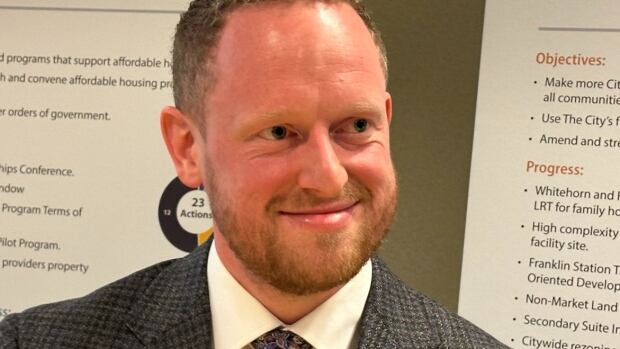
sdasd
4 Mar 2025 12:00:00
 CBC Edmonton
CBC Edmonton
Alberta's child advocate opposes change to tracking young adult deaths
Alberta’s child and youth advocate says she opposes a government move to stop her office from investigating the deaths of vulnerable young adults age 20 and older. ...More ...

Alberta’s child and youth advocate says she opposes a government move to stop her office from investigating the deaths of vulnerable young adults age 20 and older.
4 Mar 2025 11:00:00
 CBC Edmonton
CBC Edmonton
City of Edmonton charts path for violence prevention through new blueprint
City administration outlined a new plan for violence prevention in Edmonton. It focuses on how the city can keep youth and various communities safe. ...More ...

City administration outlined a new plan for violence prevention in Edmonton. It focuses on how the city can keep youth and various communities safe.
4 Mar 2025 02:53:25
 CBC Calgary
CBC Calgary
Doctors, health advocates warn Alberta's budget falls short as costs rising
There are worries the Alberta government's plans for health-care spending in the latest provincial budget will not address front-line pressures or improve access to care for patients as spending on a ...More ...

There are worries the Alberta government's plans for health-care spending in the latest provincial budget will not address front-line pressures or improve access to care for patients as spending on administration grows.
4 Mar 2025 00:47:41
 CBC Edmonton
CBC Edmonton
Former Manitoba judge to lead investigation into Alberta's health procurements
A former chief judge of the Provincial Court of Manitoba will lead an investigation into the procurement practices of Alberta Health and the province’s health authority. ...More ...

A former chief judge of the Provincial Court of Manitoba will lead an investigation into the procurement practices of Alberta Health and the province’s health authority.
4 Mar 2025 00:45:33
 CBC Edmonton
CBC Edmonton
Edmonton man, 57, designated a dangerous offender for sexual crimes against boys
A 57-year-old man with a long criminal history of sexual offences against boys is now deemed a dangerous offender, Court of King's Bench Justice Doreen Sulyma decided Monday. ...More ...

A 57-year-old man with a long criminal history of sexual offences against boys is now deemed a dangerous offender, Court of King's Bench Justice Doreen Sulyma decided Monday.
4 Mar 2025 00:35:29
 CBC Calgary
CBC Calgary
Closing arguments take place in Banff stabbing trial
A B.C. man on trial for murder “took a knife out and used it in a fist fight,” prosecutor Kaitlyn Perrin told jurors Monday as closing arguments took place in the case of a fatal stabbing that too ...More ...

A B.C. man on trial for murder “took a knife out and used it in a fist fight,” prosecutor Kaitlyn Perrin told jurors Monday as closing arguments took place in the case of a fatal stabbing that took place in Banff in 2022.
3 Mar 2025 23:59:47
 CBC Edmonton
CBC Edmonton
Smith faces second challenge from caucus member as MLA speaks out against budget
For the second time in less than a week, Alberta Premier Danielle Smith is facing pushback from within her own United Conservative caucus. ...More ...

For the second time in less than a week, Alberta Premier Danielle Smith is facing pushback from within her own United Conservative caucus.
3 Mar 2025 23:37:07
 CBC Calgary
CBC Calgary
'I was a drunken young man': Cold case killer admits to fatally stabbing teen girl 49 years ago
A 49-year-old cold case homicide was put to rest inside a Calgary courtroom on Monday with both the killer and his teenage victim’s daughter speaking publicly for the first time since murder charges ...More ...

A 49-year-old cold case homicide was put to rest inside a Calgary courtroom on Monday with both the killer and his teenage victim’s daughter speaking publicly for the first time since murder charges were announced.
3 Mar 2025 22:46:25
 CBC Calgary
CBC Calgary
MRU students say parking situation hasn't improved after 2 semesters of tougher rules
It’s been nearly two semesters since Mount Royal University introduced enhanced parking rules on campus — and added an onsite impound lot — but some students say core issues of affordability and ...More ...
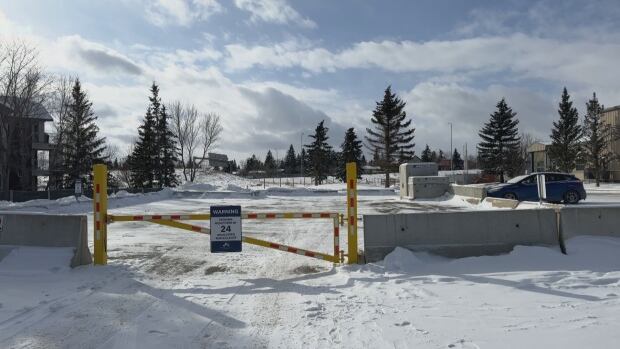
It’s been nearly two semesters since Mount Royal University introduced enhanced parking rules on campus — and added an onsite impound lot — but some students say core issues of affordability and lack of space persist.
3 Mar 2025 22:22:37
 CBC Edmonton
CBC Edmonton
Canada's military should fix white supremacy problem before it starts: analyst
Political scientist Andy Knight says his research suggests current attitudes within the Armed Forces favour white, male and Christian cultures and put groups like women, people of colour, newcomers an ...More ...
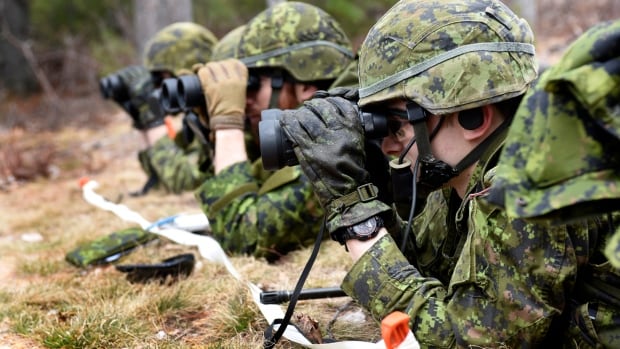
Political scientist Andy Knight says his research suggests current attitudes within the Armed Forces favour white, male and Christian cultures and put groups like women, people of colour, newcomers and the 2SLGBTQ+ community at a disadvantage. Knight, with the University of Alberta, is to meet with defence and military officials in Ottawa to discuss his findings and recommendations.
3 Mar 2025 21:05:52
 The Orchard
The Orchard
ICYMI: Feb. 24 - March 2
I watched an old episode of Real Time with Bill Maher and went on I Hate Bill Maher to talk about it with comedian and former Calgarian Will Weldon.At the Progress Report, I wrote about some of the co ...More ...
I watched an old episode of Real Time with Bill Maher and went on I Hate Bill Maher to talk about it with comedian and former Calgarian Will Weldon.
At the Progress Report, I wrote about some of the companies that received the largest nursing contracts from Alberta Health Services over the past two years, which I had to obtain through FOIP because they weren’t being publicly disclosed.
I also wrote about the 2025 Alberta budget’s ramifications for education, both K-12 and post-secondary. Readers of this newsletter might be interested to know that MaKami College is now getting public funding.
I had to delay Part II of my story on the police violence directed at the University of Calgary Palestine encampment last year while I seek comment from the cops. It should be out tomorrow.
In the meantime, you can catch up on Part I.
And you can read the story I wrote last year on the University of Alberta encampment.
What I’ve Been Reading
Story of the Week
3 Mar 2025 14:03:47
 CBC Edmonton
CBC Edmonton
Small town in rural Alberta scrambling after learning its only medical clinic is set to close
The Wembley medical clinic is closing after one of its family doctors has decided to move and the other is under a practice permit restriction. Town officials are working to find a solution. ...More ...

The Wembley medical clinic is closing after one of its family doctors has decided to move and the other is under a practice permit restriction. Town officials are working to find a solution.
3 Mar 2025 13:00:00
 Taproot Edmonton
Taproot Edmonton
On the agenda: Community revitalization levy, violence prevention, transit priority
This week, council committees will meet to debate whether to extend the community revitalization levies in downtown and the Quarters, hear about the city's new plan to prevent violence, and discuss mo ...More ...
This week, council committees will meet to debate whether to extend the community revitalization levies in downtown and the Quarters, hear about the city's new plan to prevent violence, and discuss more locations for transit priority measures.
There is a community and public services committee meeting scheduled for March 3, an urban planning committee meeting scheduled for March 4, and an executive committee meeting scheduled for March 5.
Here are key items on this week's agenda:
- The community revitalization levies in the Quarters and downtown may be extended, according to reports scheduled to be presented to executive committee on March 5. The CRLs are tools for municipalities to rejuvenate underdeveloped areas by allowing public infrastructure investments to attract private investments that can repay the public investment. Within the levy area, a baseline property assessment is established, and for up to 20 years, increases in property tax revenue above that baseline, resulting from new development and property value growth, go toward the CRL. That means new developments essentially repay for infrastructure investments. The Quarters CRL has so far been used to build $100 million worth of projects, which include The Armature pedestrian path, Kinistinâw Park, and the adaptive reuse of spaces the city owns for the arts. These projects have attracted private developments like The Hat, Double Tree Hotel, and Stadium Yards. However, the city said its projections show that there has not been enough private investment in the Quarters to pay for the infrastructure investments, due in part to the COVID-19 pandemic, opioid epidemic, increased construction costs, and worsening social disorder. Council could apply to extend the levy in the Quarters by 20 years and add five new projects. One project proposes to redraw the street grid in the Quarters by breaking up large blocks, which would create more opportunities for north-south access through the neighbourhood and allow easier land consolidation, the report said. The downtown CRL, meanwhile, has been more effective; the city said infrastructure investments downtown have attracted more than $4.7 billion of new investment, with 3,500 housing units completed or under construction since the levy came into effect in 2015. Council could apply to extend the downtown levy by 10 years and add new projects. Administration said it could use the downtown levy to improve LRT entrances, remediate empty contaminated lots, and contribute to an outdoor event space at the ICE District. If council approves extending both levies, the province would need to approve the extensions. The province announced on Feb. 28 it is working with the city and the Oilers Entertainment Group to provide funding for the ICE District event space and other projects in Edmonton's core.
- Administration will present its new Blueprint for Violence Prevention at a community and public services committee meeting on March 3. The plan's three goals are to strengthen and connect government structures; prevent or interrupt violence that is already occurring through tailored strategies; and tackle structural and social issues that can cause violence. Some actions the city plans to take are to establish a violence and crime reduction board, grant adequate and sustained funding, and engage the public on its role in violence prevention.
- City staff have developed a metric to calculate transit passenger delay hours, which measures both ridership and traffic congestion delays to identify routes that could benefit from transit priority measures. The new locations identified by the metric include 114 Street NW between Belgravia Road NW and 87 Avenue NW, 107 Avenue NW between 120 Street NW and 156 Street NW, 124 Street NW between 107 Avenue NW and Jasper Avenue NW, and the area around Clareview Transit Centre. The routes are outlined in a report scheduled to be presented to council's urban planning committee on March 4. In other areas, the city is already implementing such measures, like dedicated bus lanes, queue jumps, and intersection modifications, but there is no funding available to address the newly identified routes. Administration said it will develop a program to identify locations that need transit priority measures and funding.
The city has identified more areas in Edmonton that could benefit from transit priority measures. (Stephanie Swensrude)
Here are some other items on the agenda:
- Council's urban planning committee will review the Edmonton Design Committee's new proposed principles of urban design at a meeting on March 4. The committee has been reworking its principles as well as its scope of review for the past year. The committee's current principles, which number in the dozens, would be replaced by six themes: Authentic and meaningful; healthy and inclusive; attractive and human-scaled; connected and walkable; resilient and sustainable; and vibrant and thriving. The committee aims to finalize the changes by the end of April.
- The Edmonton Transit Service Advisory Board wrote a report about the perception of LRT safety. Data suggests that crime on public transit is trending down. Comparing the third and second quarters of 2024, reported violent crimes fell by 33% and calls for service to transit peace officers fell by 25%. Despite this, survey respondents consistently identified safety as a major concern, the report said. Lighting, cleanliness, environmental design, a feeling of isolation, and a lack of people are some factors identified that contribute to riders feeling unsafe. Administration is scheduled to return to council in March with a report outlining additional options to enhance safety on the LRT.
- The city has developed a work plan with 11 strategies to address the gap between revenue and expenses. The action items include to review fees for all city services including transit, recreation, and parking; create a proposed policy that would ensure renewal projects are advanced before growth projects; review city-owned land to see what could be sold; and advocate for more financial support from the province.
- Administration has developed two grant programs meant to encourage new stores. The proposed programs are meant to replace the development incentive program, which closed in 2023. The first program would offer up to $30,000 for interior renovations to vacant ground floor commercial units, while the second would offer up to $400,000 per year to support the construction of new commercial and mixed-use developments. The proposed programs are set to be presented to council's executive committee at a meeting on March 5. Executive committee may make a recommendation and send the decision to a future council meeting for a vote.
- The City of Edmonton plans to sell two downtown office buildings, Chancery Hall and Century Place, and relocate 1,350 staff as part of a $22.7-million project to optimize workspaces. If approved by city council, funding would come from an interim financing reserve, with repayment expected from building sale proceeds and cost savings. Council's executive committee is expected to give a recommendation on the sale at a meeting on March 5.
Meetings stream live on YouTube on the Chamber channel and River Valley Room channel.
3 Mar 2025 13:00:00
 Taproot Edmonton
Taproot Edmonton
Police commissioner's link to healthcare scandal could create turmoil, podcasters say
A newly reported link between a provincial appointee to the Edmonton Police Commission and a businessman at the centre of corruption allegations within the province's healthcare system may create turm ...More ...
A newly reported link between a provincial appointee to the Edmonton Police Commission and a businessman at the centre of corruption allegations within the province's healthcare system may create turmoil for the commission, the co-hosts of Episode 297 of Speaking Municipally said.
"I think there's nothing the public is more interested in politically right now than this scandal and everything it affects," co-host Troy Pavlek said.
Public Safety Minister Mike Ellis appointed cardiac surgeon Jayan Nagendran to the Edmonton Police Commission in May 2023. At the time, Nagendran was a co-director alongside Sam Mraiche of a numbered company and the surgical director for lung transplantation at Alberta Health Services. Mraiche owns 25% of two surgical facilities operated by Alberta Surgical Group, which has reportedly charged more than double the standard fees for hip replacements. Mraiche also signed a $70-million contract with the province in 2022 to import children's pain medication from Turkey. Athana Mentzelopoulos, the former president and CEO of AHS, alleged in a wrongful termination suit filed in February that she was pressured to make deals with Alberta Surgical Group.
The suit is not yet settled by the courts, and two reviews are still underway by Alberta's auditor general and an unnamed third party, per The Canadian Press.
Pavlek noted that public scrutiny has pushed police commissioners to resign in the past. In December, John McDougall resigned after sharing plans to continue his role despite moving to Portugal, and in January, Dan Jones resigned after his appointment was criticized by former police chief Dale McFee, who has just been appointed by the UCP government as deputy minister of executive council and the head of Alberta Public Service. Nagendran's term on the police commission is set to expire in April 2026.
"We're seeing the police commission makeup shift a little bit," Pavlek said. "It shows that this board is not invulnerable to public outcry."
The Feb. 28 episode of Taproot's civic affairs podcast also covered ongoing discussions of bridge maintenance around downtown, the idea behind an infrastructure committee, and council's decision to approve a rezoning to allow a Nordic spa in the river valley. Plus, Taproot's managing editor, Tim Querengesser, provided an update from the Taproot newsroom. Speaking Municipally comes out on Fridays. Listening and subscription options are all right here.
3 Mar 2025 13:00:00
 CBC Calgary
CBC Calgary
Veteran Calgary city councillor bowing out after 15 years in politics
Peter Demong has represented Ward 14 in the deep southeast corner of the city since 2010. A former small businessman, he went to city hall with a tax-fighting zeal that has moderated a bit over time a ...More ...
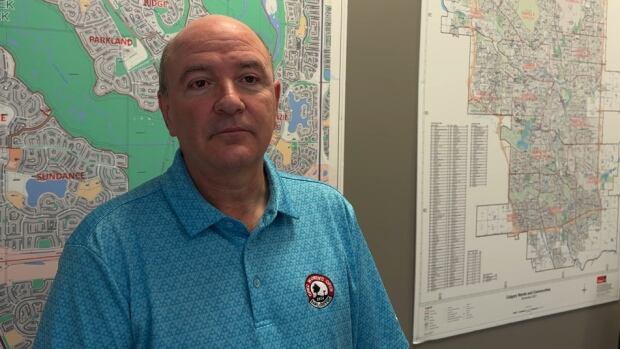
Peter Demong has represented Ward 14 in the deep southeast corner of the city since 2010. A former small businessman, he went to city hall with a tax-fighting zeal that has moderated a bit over time as he learned more about the place.
3 Mar 2025 12:00:00
 CBC Calgary
CBC Calgary
Farkhunda Muhtaj is playing for something bigger than soccer
The Calgary Wild FC midfielder will soon become part of history as one of the players lining up for the inaugural season of the Northern Soccer League, the first women's professional soccer league in ...More ...

The Calgary Wild FC midfielder will soon become part of history as one of the players lining up for the inaugural season of the Northern Soccer League, the first women's professional soccer league in Canada. Proud of her faith and cultural heritage, she's fasting for the month of Ramadan while taking part in preseason preparations.
3 Mar 2025 12:00:00
 CBC Edmonton
CBC Edmonton
Mayerthorpe, 20 years after the RCMP shootings
On March 3, 2005, four RCMP constables were killed near Mayerthorpe, Alta. The town of 1,300 has since become synonymous with the tragedy. Twenty years later, some Mayerthorpe residents reflect on the ...More ...
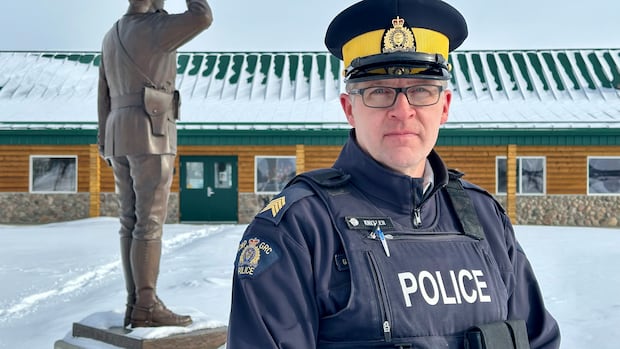
On March 3, 2005, four RCMP constables were killed near Mayerthorpe, Alta. The town of 1,300 has since become synonymous with the tragedy. Twenty years later, some Mayerthorpe residents reflect on the events and how they've moved forward.
3 Mar 2025 09:00:00
 CBC Calgary
CBC Calgary
Calgary's Ukrainian community rallies after Trump-Zelenskyy clash
Hundreds of people rallied at Calgary's Municipal Plaza Sunday in the wake of a heated exchange between Ukrainian President Volodymyr Zelenskyy and U.S. President and Vice-President Donald Trump ...More ...

Hundreds of people rallied at Calgary's Municipal Plaza Sunday in the wake of a heated exchange between Ukrainian President Volodymyr Zelenskyy and U.S. President and Vice-President Donald Trump and JD Vance at the White House on Friday.
3 Mar 2025 02:29:28
 CBC Calgary
CBC Calgary
NHL honours Johnny and Matthew Gaudreau in emotional Stadium Series tribute
The Stadium Series game between Columbus and Detroit on Saturday promised to have it all: a crowd of more than 90,000 — the second largest in NHL history — and an electric atmosphere at Ohio Stadi ...More ...

The Stadium Series game between Columbus and Detroit on Saturday promised to have it all: a crowd of more than 90,000 — the second largest in NHL history — and an electric atmosphere at Ohio Stadium. The NHL also ensured a key figure was front and centre.
2 Mar 2025 18:39:08
 CBC Calgary
CBC Calgary
'It's like attending a funeral': Calgary Cannons owner, former GM, among those mourning Foothills Stadium
The city is in the process of tearing down Foothills Stadium as part of its plan to revitalize Foothills Athletic Park. The stadium was once home to the AAA baseball team, the Calgary Cannons. ...More ...
The city is in the process of tearing down Foothills Stadium as part of its plan to revitalize Foothills Athletic Park. The stadium was once home to the AAA baseball team, the Calgary Cannons.
2 Mar 2025 16:41:01
 CBC Edmonton
CBC Edmonton
Q&A: Edmonton death educator breaks taboos on end-of-life planning
An Edmonton-based death educator and certified executor advisor is dedicated to using education to demystify end-of-life topics, like funeral practices, wills and estates, and executorship. ...More ...

An Edmonton-based death educator and certified executor advisor is dedicated to using education to demystify end-of-life topics, like funeral practices, wills and estates, and executorship.
2 Mar 2025 15:00:00
 CBC Calgary
CBC Calgary
Does Alberta spend the least, per-student, on public schools? Maybe not. But it's definitely down there
The Alberta Teachers Association and the Fraser Institute, a right-leaning think tank, have both independently concluded that Alberta spends the least, per student, on public schools of any province. ...More ...

The Alberta Teachers Association and the Fraser Institute, a right-leaning think tank, have both independently concluded that Alberta spends the least, per student, on public schools of any province. But StatsCan says calculating that is not quite as simple as they make it out to be.
2 Mar 2025 14:00:00
 CBC Edmonton
CBC Edmonton
Here's what the experts say about sleeping with your mouth taped
The wellness industry's latest darling — mouth taping during sleep — has been increasingly infiltrating social media algorithms. But where did the trend come from? And, perhaps more importantly, ...More ...

The wellness industry's latest darling — mouth taping during sleep — has been increasingly infiltrating social media algorithms. But where did the trend come from? And, perhaps more importantly, is it good for you?
2 Mar 2025 11:00:00
 CBC Edmonton
CBC Edmonton
What Jasper’s new interim housing neighbourhoods are like
Jasper, Alta., residents, who were displaced by a wildfire that destroyed one-third of the town's buildings in July, are finally getting to move into new interim housing neighborhoods. In a CBC exclus ...More ...

Jasper, Alta., residents, who were displaced by a wildfire that destroyed one-third of the town's buildings in July, are finally getting to move into new interim housing neighborhoods. In a CBC exclusive, reporter Acton Clarkin gets an inside look at the makeshift communities.
2 Mar 2025 09:00:00
 CBC Edmonton
CBC Edmonton
Sculpture of this escapee pig is at risk of theft
In the 90's, Francis the Pig escaped a Red Deer slaughterhouse to live on the loose for five months before being caught. A popular sculpture in his honour was almost stolen, which led to artist Danek ...More ...

In the 90's, Francis the Pig escaped a Red Deer slaughterhouse to live on the loose for five months before being caught. A popular sculpture in his honour was almost stolen, which led to artist Danek Mozdzenski making the artwork harder to run away with.
2 Mar 2025 03:54:11
 CBC Calgary
CBC Calgary
Alberta prepares as wildfire season begins
Already this week, firefighters had to bring a fire burning west of Ghost Lake, north of Highway 1A, under control. ...More ...
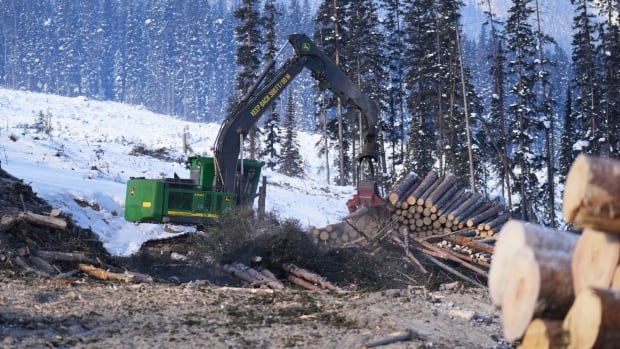
Already this week, firefighters had to bring a fire burning west of Ghost Lake, north of Highway 1A, under control.
1 Mar 2025 12:00:00
 CBC Edmonton
CBC Edmonton
'Uncertainty is almost as bad as the tariffs themselves': Tariff threat alone hurts Alberta
Donald Trump’s tariff threats have been top of mind for Canadians since he took control of the White House. But whether or not that threat actually materializes, some are concerned the uncertainty i ...More ...

Donald Trump’s tariff threats have been top of mind for Canadians since he took control of the White House. But whether or not that threat actually materializes, some are concerned the uncertainty is already affecting business operations north of the border.
1 Mar 2025 12:00:00
 CBC Edmonton
CBC Edmonton
Confusion, questions surround new Alberta policing committee obligations
New rules requiring Alberta municipalities to form or join policing committees that oversee RCMP have now come into effect but some communities have yet to form them and still have questions about how ...More ...
New rules requiring Alberta municipalities to form or join policing committees that oversee RCMP have now come into effect but some communities have yet to form them and still have questions about how they will work.
1 Mar 2025 11:00:00
 Alberta Views
Alberta Views
Juiceboxers
by Benjamin HertwigFREEHAND BOOKS2024/$24.95/300 pp. Juiceboxers is Benjamin Hertwig’s first novel—and you’d never guess. Upon reading, you might think it was his tenth. It’s confident, intell ...More ...
Juiceboxers is Benjamin Hertwig’s first novel—and you’d never guess. Upon reading, you might think it was his tenth. It’s confident, intelligent and extremely well written—and it’s the first Canadian novel to come out of Canada’s military involvement in Afghanistan.
Following the 9/11 attack on the World Trade Center in New York City, Canada joined the international military campaign against Afghanistan’s Taliban government, which was believed to be supporting, and possibly harbouring, the terrorist group Al-Qaeda. Canada’s military involvement after 2005 was concentrated in the dangerous Kandahar region of Afghanistan, where 2,300 Canadian soldiers were deployed.
Juiceboxers is the story of four Edmonton teenagers who join the military and go on to serve in Kandahar. They meet as army cadets in Edmonton and do their basic training together in Wainwright. The main character, Plinko, gets his nickname from a video game, but once he’s known as that, the nickname sticks and won’t come off. But what the heck, even a dumb nickname is a sign of being known and perhaps accepted.
While in training, Plinko and his friends Abdi and Walsh are asked by another army trainee, Krug, if they want to rent rooms in Krug’s house. It seems like a good idea, even though they are leery of him. Krug is, to say the least, crude. He’s foul-mouthed, porn-addicted and violent. He’s in their face at all times—the kind of guy who drops and does push-ups just for that bit of tough-guy edge. Krug calls his place “The House of Guns,” and has the hardware to back it up. He seems so theatrically evil that his three roomies assume it can’t be real.
The young men’s reasons for wanting to be soldiers are not deep, nor is it a big topic among them. Krug feels he was born for it. Plinko thinks it would be cool. Abdi, whose parents are from Somalia, is looking for inclusion—and so is Walsh, for reasons the novel will reveal.
Krug calls the other three “queers” because they aren’t tough like him. He makes fun of Abdi’s being brown. Plinko really likes Abdi and Walsh and envies the closeness of their friendship. He also envies them their close and supportive families, who are pleasant with Plinko in ways his own family isn’t.
And then the four are in Kandahar, where the rubber of playing soldiers hits the road of a dangerous war.
Benjamin Hertwig is from Edmonton and he served in the Canadian armed forces in Kandahar. Prior to this novel he wrote a book of poetry titled Slow War, also rooted in his military experience. Slow War was shortlisted for a Governor General’s Award and won the Writers’ Guild of Alberta’s Stephan G. Stephansson Award for Poetry.
Juiceboxers is not just a great first novel, it’s a great any-time-in-your-career novel. I believe it will be recognized as one of Canada’s best novels of war. It has what Norman Mailer’s The Naked and the Dead and Michael Herr’s Vietnam memoir Dispatches had: the boredom and terror of being a soldier in modern, highly mechanized warfare. Both those now-famous books more or less created a style to suit their subject, a way to bring it all uncomfortably close, close enough to feel and smell. Like those works, Hertwig’s novel is skillful, emotional and carries authentic weight. What Juiceboxers brings that goes beyond most other novels or memoirs of war is a heart-rending depiction of PTSD—the afterlife of a soldier. When Plinko gets away from war, his problems don’t go away; they grow.
This is also, importantly, a novel of friendship. Even Krug, who seems mostly brutal and hateful, is revealed as vulnerably human and more tragic than vile in the end. Plinko and the others from the House of Guns don’t see one another much after Kandahar, but, in some other sense, they are stitched together, whether they want to be or not.
Fred Stenson’s many books include the novels Who By Fire, The Trade, Lightning and The Great Karoo.
_______________________________________
Click here to sign up for our free online newsletter.
The post Juiceboxers appeared first on Alberta Views.
1 Mar 2025 10:10:15
 Alberta Views
Alberta Views
Should National Parks Have Entrance Fees?
Kevin Van Tighem says YES Alberta-born author, naturalist and former Banff National Park superintendent (2008–2011) Over four million people visited Banff National Park in 2023. Some got lost ...More ...
Kevin Van Tighem says YES
Alberta-born author, naturalist and former Banff National Park superintendent (2008–2011)
Over four million people visited Banff National Park in 2023. Some got lost or hurt and had to be rescued. Others fed bears and had to get straightened out. All flushed toilets, drove on roads and parked in parking lots. Campgrounds had to be maintained. Signs, picnic tables and boardwalks had to be repaired. The list goes on. It’s costly.
A lot of Canadians, however, didn’t visit Banff or any other national park—either because they couldn’t afford to or weren’t interested. It’s not clear why their tax dollars should finance holidays enjoyed by others.
Should the occupants of all those vehicles streaming into the park each day pay their own way? Of course they should; they get to enjoy a costly privilege that others don’t. But the core costs associated with national parks should be funded through the public treasury. That’s not a contradiction, because it’s not the same thing.
National parks are institutions that represent the part of our Canadian identity defined by our nature and our history. Parks ensure we’ll always be able to know ourselves, because we’ll always be able to find ourselves. That mandate is a benefit to all—visitors or not—and a legacy to future generations. Like our national archives, military, treaty obligations and other institutions, it makes sense to fund our parks with tax revenues.
And, in fact, every Canadian should be welcome to visit and be inspired by their national parks without paying a fee. The parks are ours, by virtue of citizenship. But here’s the problem: when we choose to visit by means of a vehicle, that creates costs unrelated to protecting heritage—and compromises that very mandate. Without cars, we wouldn’t need to replace wildlife habitat with kilometres of paved highway lined with noxious weeds. Without cars there wouldn’t be bear jams and traffic gridlock. Snowplowing, parking lots, fencing, roadkill—all are in service of vehicles and those of us who insist on using them.
When I was responsible for Banff National Park I did a little back-of-the-envelope calculation and found that well more than 75 per cent of the park’s budget went to providing for the use of—or mitigating the impacts of—vehicles. Recently congestion has brought parts of that park to a virtual standstill. An added irony: the exhaust gases spewing from those engines contribute to a climate disaster that makes park protection increasingly hopeless as glaciers melt, fires burn and wildlife comes under growing stress. In Banff’s case the problem is compounded by a species of mandate creep that has turned a protected heritage place—dedicated only to future generations of Canadians—into an international tourism resort. More vehicles.
So here’s my idea: the basic costs of protecting parks—our national birthright—should be fully funded by tax revenues. Canadians arriving on their own two feet should get in for free. But anyone who comes by vehicle should pay a substantial fee that accounts for the full cost of that privilege. No free rides.
Ian Urquhart says no
U of A professor emeritus and former editor of the AWA’s Wild Lands Advocate
Free admission to Canada’s national parks was a gift Ottawa gave Canadians in 2017 for this country’s 150th birthday. It was a good idea then; it’s a good idea now.
Entrance fees are a revenue source for Parks Canada, albeit a small one. In 2022/23 the agency spent $1.28-billion; entrance fees paid for $91.5-million, or 7 per cent, of those expenses. Why get rid of these fees? I recently posed this question to Catherine McKenna, the federal minister who delivered free admission to national parks in 2017. Today she strongly believes parks should be free “because we need people to understand the value of nature,” and that spending time in the outdoors may be the best way to do that. She suggested free admission helps parks promote many values, including health, equality, biodiversity, climate change mitigation and Indigenous partnerships. I agree, and I’ll just address two of them.
Research into the nature–human relationship clearly shows the health benefits of spending time in nature. Greenspace exposure reduces high blood pressure, high HDL cholesterol and cardiovascular mortality. Nature delivers similar mental health benefits. Connectedness with nature reduces stress while increasing happiness and cognitive abilities.
The research demonstrates parks are essential health care institutions. Dr. Melissa Lem agrees. She’s the director of PaRx, Canada’s prescription for nature program. Parks Canada has partnered with Lem’s program to enable registered health professionals to prescribe an annual park pass to patients. Alberta doctors who register with PaRx can prescribe this access to Alberta’s outstanding national parks. Calgary physician Andrea Hull regards PaRx as “an exciting way to showcase the health benefits of time in nature.”
Inequality is another important foundation for opposing entrance fees. User fees discourage people with lower incomes from participating in outdoor activities. Personally, $22 for a day pass to Banff isn’t going to stop me from visiting, but I’m lucky. The cost of a family day pass or annual pass ($151.25) puts time in national parks beyond many people’s reach.
I couldn’t support abolishing entrance fees if I thought it would mean damage to the parks. Maintaining and restoring ecological integrity is the first priority of managing the national parks. But the experience of 2017, when entry was free, allays my concerns. Parks Canada used other measures, such as buses and area closures, to manage the increase in visitors.
Banff National Park’s assessment of the 2017 season argued that McKenna’s decision was ultimately justified. Free passes “allowed more Canadians… to connect with these wonderful places that are actually their places.” The feared additional damage to nature from more visitors didn’t arise.
As minister of environment and climate change, McKenna favoured this tagline for our parks: “Discover. Connect. Protect.” Today let’s adopt it and add the word “Free.”
kevin van tighem responds to ian urquhart
Ian Urquhart argues that national parks should be free to Canadians because of parks’ health benefits. It’s hard to disagree with that view, but to an unfortunate degree it’s an idealistic one that doesn’t reflect the actual park experience for many visitors. It’s hard to see how sitting in a traffic jam on Banff Avenue or jostling with the crowds that throng the Lake Louise shoreline is good for health. If anything, the tension experienced by visitors during crowded times—which, increasingly, is most of the time—frays tempers and exacerbates the social stresses those visitors went to their parks to escape. That’s not healthy.
Minister McKenna’s 2017 decision to provide free access to Canada’s national parks was not the painless success that Urquhart suggests. Yes, in many less visited parks and historic sites, Canadians did connect to their heritage. But Alberta’s already crowded mountain parks saw worse traffic, bigger crowds and the diversion of budgets from priorities such as trail maintenance and wildlife management to crowd-control. When a national park visit becomes an exercise in navigating traffic cones, being directed into emergency parking lots by safety-vest-clad employees, crowding onto buses and waiting endlessly, something has gone wrong. It certainly wasn’t good healthy fun for anyone, including those harried park employees.
Yes, Parks Canada scrambled to mitigate the challenge by setting up public transportation. But those buses, signs and flag-people came at a cost. Nothing is free, after all. Somebody has to pay. In 2017 it was Canadian taxpayers who picked up the tab. I’m not sure how this was fair to the large percentage of those taxpayers who chose not to visit a park that year—partly because of the well-publicized crowding issues.
Nothing guarantees a right to private vehicle use in the parks. Kilometres of pavement compromise nature.
Social equity challenges don’t just involve the cost of getting into a park. People who can’t afford a park pass generally live far from national parks. The economic challenges involved in enjoying those parks include the cost of transportation to get there, finding accommodation and paying inflated prices for meals and other amenities in parks that have been taken captive, to a considerable degree, by a tourism industry that targets well-off motorized travellers. Low-income Canadians unquestionably deserve the opportunity to experience their national parks, but the cost of admission is often the least of the barriers they face.
For all those quibbles, I generally agree with Urquhart. National parks are meant to benefit every Canadian; every Canadian should be able to enjoy them for free. But the traditional emphasis on private motor vehicles can make parks less than enjoyable.
Public transportation is one way to democratize access to the national parks. For that truly to work, it has to include not just internal options such as Banff’s Roam bus service but also services to help Canadians get to their parks from the cities and towns where most of us live. That’s a costly proposition, given that the country’s infrastructure is built around the private vehicle. It was no accident, after all, when Greyhound folded. Cars rule.
But the value of good, affordable public transportation to and in our national parks would go beyond social equity; it’s a critical part of any meaningful response to the climate crisis—a crisis that threatens both human health and the natural environment.
So how could we pay for it? Collect high fees from those who insist on driving their vehicles to the parks. Progressive economic policy requires that those who demand special benefits that work against the public good should pay dearly for their privilege.
Nothing in the Canada National Parks Act guarantees a right to private vehicle use in the parks. As Urquhart points out, parks’ first priority is the protection of ecological integrity, something inevitably compromised by the kilometres of pavement covering what was once wildlife habitat; the hundreds of birds, mammals, amphibians and insects killed each year by vehicles; and the climate chaos engulfing us because of all the CO2 those cars release.
National parks are dedicated to future generations of Canadians as places that provide for the benefit, education and enjoyment of people. Private vehicles aren’t required for that; just the opposite. Nature is off-pavement.
Anybody who doubts the need to challenge conventional car-centred logic in the management of national parks should take a trip to Banff on any summer weekend. Yes, national parks should be free to all Canadians. But not to our cars. If we charged private vehicle users the full cost of their privilege, we’d start generating the kind of revenues needed to fund public transportation for all. We might also restore the peaceful enjoyment of nature—the kind of real national park experience that is rapidly becoming roadkill.
ian urquhart responds to kevin van tighem
Kevin Van Tighem believes that anyone using a private vehicle to visit national parks should pay a “substantial fee.” Why? Because such visitors compromise Parks Canada’s heritage protection mandate. He uses Banff National Park to make the point that vehicle congestion can produce gridlock. Banff again is used to argue that managing private vehicles costs a lot of money. Such costs are compounded, in the case of Banff, by the park’s alleged transformation from “a protected heritage place” into “an international tourism resort.”
Much of his argument is Banff-based. Banff is unique, and we should be wary of generalizing from what we think is best for Banff to all national parks. That said, I believe his prescription is wrong even for Banff.
Before I critique the former superintendent’s position, readers should know he misrepresents Banff’s history. Tourism, not heritage protection, motivated the establishment of Canada’s first national park. Sir John A. Macdonald concluded Banff could be “a great place of resort” that would attract people from across North America and Europe. Banff was created to be an international tourist destination. Decades later, parks commissioner J.B. Harkin wanted the parks to serve all Canadians. Ironically—given this dialogue—he saw roads and the automobile as the way to do that. Promoting tourism is a constant, not a novelty, in Banff National Park’s history.
We agree, however, that tension between human desires and heritage protection is another constant in the history of our mountain parks. Today’s volume of vehicle traffic to Banff attests to this.
But all visitors, including those in cars, are more than simply threats to heritage protection. They are potential allies to promote that mandate. Their support for parks is an important political resource in the annual competition for Canada’s tax dollars. Building public support for Parks Canada is especially important now. The agency benefited from the 2021 federal budget’s $2.3-billion investment in nature conservation. But the funding was temporary. It will dry up in 2026–2027, and with it will go an important chunk of the agency’s budget.
All visitors are potential allies to promote heritage protection. Support is more likely when entry is free.
Parks Canada needs our support to try to secure dollars to invest in its core mandate. Support is more likely when nearly all visitors say they would recommend their experience to others. In 2022–2023, 95 per cent of visitors to Canada’s national parks surveyed said this. A new, substantially increased entrance fee, a form of double taxation, might damage or kill that support.
A substantially higher fee would also make access even more challenging for lower-income Canadians. Today, as a century ago, the car offers the most practical and affordable means of travelling to Alberta’s national parks. The least expensive round-trip bus option for a family of four going to Banff from Calgary is just under $95, or $117 with a day pass. If the same family’s SUV uses 8 litres per 100 km, the fuel cost will be less than $35.
A bus trip to Jasper is a non-starter for a family of four living in Edmonton. The only commercial bus service to Jasper would cost them $344.44—one way. And if you live elsewhere in Alberta…? An automobile is your only practical means for visiting.
The report of the expert advisory panel on moving people sustainably in the Banff Bow Valley (2022) saw pricing as one of its eight key strategies. But the panellists wrote that if a pricing strategy didn’t consider income it could “create equity issues and discourage lower-income persons from experiencing the park.” Van Tighem’s position sounds like it would do exactly that.
Do vehicles produce gridlock in parts of Banff National Park? Absolutely. But the panel suggested that serious transportation issues arose only “in a relatively small portion of the park. [Some] 97 per cent of the park is declared wilderness, where development is prohibited.” When gridlock occurs, it likely arises in the town of Banff, Lake Louise or Lake Minnewanka.
I’m writing this on a Sunday afternoon in July while looking at the Town of Banff’s traffic cams on my computer. The cameras show considerable traffic entering, leaving and driving around town. But while I’d be annoyed by this traffic if I lived in Banff, I can’t conclude the cars I’m watching constitute gridlock or pose a serious threat to heritage protection.
Without tourists, especially Canadian ones, the future of our national parks would be dim. Canadians’ support is vital to the heritage protection mandate that Van Tighem and I both value. Slapping a substantial fee on visitors who drive threatens that support. Instead of higher fees, Parks Canada should do what it does already for youth, members of the armed forces/veterans, and new Canadians—offer free entry. And let’s all join the fight for additional tax dollars.
____________________________________________
Support independent local media. Please click to subscribe.
The post Should National Parks Have Entrance Fees? appeared first on Alberta Views.
1 Mar 2025 10:00:57
 Alberta Views
Alberta Views
Problem Grizzly or Problem Politics?
Over the past five years Dr. Tyler May has noticed what he calls a “sizeable uptick” in sightings and interactions with grizzly bears in the area surrounding Manning, a town on Hi ...More ...
Over the past five years Dr. Tyler May has noticed what he calls a “sizeable uptick” in sightings and interactions with grizzly bears in the area surrounding Manning, a town on Highway 35 next to the Notikewin River, approximately 600 kilometres northwest of Edmonton. May, born and raised in Manning, grew up on a small grain farm. His grandfather was a hunting outfitter and ran a trapline in the Chinchaga, an expanse of boreal forest directly west of Manning. After graduating from medical school in Dublin, Ireland, May moved back to the north in 2013 to work as a physician at the Manning Community Health Centre. Today, with his family, he manages a grain and cattle operation, raising 250 head on pastures adjacent to the boreal forest. “We’re seeing more signs of grizzly activity closer to where we live,” May says, citing regular sightings of tracks along the creek that runs through their cattle lease, bears caught on his neighbour’s trail cameras and a grizzly preying on a neighbour’s horse.
Most concerning to May, however, is an increase in livestock loss and injury from what he believes could be grizzly bear predation. He acknowledges it’s difficult to say for sure, when you’re running a remote operation. “Even if they’re on a kill, did they kill it or did it die naturally? I haven’t seen a grizzly actually kill anything.” But this year he’s seen three injured cows with open wounds, which leads May to believe they’re being chased by something.
A moratorium on hunting has resulted in grizzly bear populations stabilizing
May admits his perspective is purely anecdotal. A population estimate conducted for grizzlies in the Chinchaga area in 2021 identified only 16 individual bears and estimated a density of 0.7 grizzlies per 1,000 km, which is the thinnest grizzly density in Alberta’s bear management zones. But May isn’t alone in his concerns. He and his neighbours aren’t inherently fearful of bears, he says, but rather of what he calls the “punitive nature” of Alberta’s laws: namely, that it’s been illegal to shoot or hunt a grizzly bear in Alberta since 2006. That’s what leads to the “shoot, shovel, shut up” mentality, he says, or the illegal killing, or poaching, that continues to be one of the leading causes of grizzly bear mortality in Alberta. “The sort of vigilante stuff, where people are taking measures into their own hands.”
In August 2024 May received an email from AlbertaRELM, the province’s regulatory body for hunting and fishing licensing, inviting eligible Albertans—licensed hunters—to become potential “wildlife management responders” to track and euthanize “problem” grizzly bears. “Just about everybody who hunts up here applied,” says May, of the local response to Alberta’s new grizzly management policy. “I don’t think grizzly bears have a lot of friends up here. They have a role to play [in the ecosystem], but people don’t want them in their yards—and for good reasons.”
Grizzly bears evoke polarizing emotions in Alberta. While some people perceive them as a symbol of an intact wilderness, an iconic species to be conserved, others view them as a “pest” or a “problem” to be removed. Research at the University of Alberta shows that Albertans, regardless of their stance on grizzly bear conservation, agree on the importance of “improving policy processes and decision-making” to build trust between different interest groups. In doing so, the province is more likely to achieve positive “outcomes for human–bear coexistence.” But the Alberta government has a track record of impeding constructive dialogue when it comes to grizzly bears, says human–bear conflict researcher Douglas Clark, particularly in the context of government “decision-making processes that leave everyone unsatisfied and angry at one another.”
In 2002, when the local grizzly population was about 1,000 mature adults, the province’s Endangered Species Subcommittee recommended that grizzly bears be listed as “threatened.” The Alberta government declined, though they did assemble a team of grizzly bear specialists to put together a Grizzly Bear Recovery Plan for seven different bear management areas (BMAs) across Alberta, with the goal of reducing human-caused bear mortality and human–grizzly bear conflict through mitigating food attractants, securing habitat and educating the public through a BearSmart program. The draft recovery plan was submitted in 2005—when the grizzly bear population had fallen to 700 adults—but the grizzly bear hunt remained open. Then, in a move widely covered in the media, the province’s leading grizzly bear biologist, Gordon Stenhouse, was reassigned from his position after speaking publicly about the plan’s failure to address the impact of the grizzly bear hunt. A few months later the grizzly bear hunt was suspended. It would take eight years after the initial recommendation for the Alberta government to finally list grizzlies as a threatened species under Alberta’s Wildlife Act in 2010.

A young grizzly foraging next to railway infrastructure near Grande Cache. Since the Alberta government banned the hunting of grizzlies in 2006, the population has stabilized, and even increased in some areas, though the bears are still considered threatened in the province.
Nearly two decades of a moratorium on hunting, coupled with conservation efforts, has resulted in grizzly populations stabilizing in some BMAs and increasing in others. In BMA4, which covers the Rockies and the eastern slopes from the Trans-Canada Highway to Rocky Mountain House, for instance, the number of grizzlies nearly doubled (to an estimated 88 bears). The latest population census, in 2021, estimated the grizzly population in Alberta to be between 856 and 973 bears—an increase, but not enough to be delisted as a threatened species.
Still, in recent years, hunting and outfitting associations have been lobbying the Alberta government to reinstate a limited season on hunting grizzly bears. “We should target problem bears first,” wrote author and hunter T.J. Schwanky in an op-ed published in Outdoor Canada in August 2021. “This could easily be done if landowners and Fish and Wildlife officials work together to give licence holders access to the bears.”
Nearly three years later, on June 17, 2024, Alberta’s minister of forestry and parks, Todd Loewen, quietly amended the Wildlife Act to authorize “hunting a grizzly bear” if the bear “is involved in a human–bear conflict situation,” or “is in an area of concern.” On July 9 the ministry issued a press release announcing a new grizzly bear management strategy involving “a new network of wildlife management responders to help stop dangerous and deadly grizzly bear attacks on people and livestock.”
According to the amended regulation, when a “problem” grizzly is reported, and a wildlife officer deems the new “grizzly bear management” strategy to be appropriate, a licensed hunter will be chosen from a list to kill the bear—so long as they can be “onsite within 24 hours.” By September 24, about 7,000 licensed hunters had applied for a slot. From that list, 30 hunters have been shortlisted, with 10 each in the north, central and south regions of the province. Hunters will be able to keep all parts of the bear except the gallbladder (which is highly coveted in Asia for its medicinal properties and illegal to export from Alberta).
Loewen told media that on average roughly 20 problem grizzlies are killed due to “negative human interactions” each year in Alberta, and that up to 15 could be killed annually under the new policy. But those numbers aren’t backed up by provincial statistics, which show that from 2013 to 2022 some 23 grizzlies were killed in self-defence and another 57 for agency removal—eight a year on average, significantly fewer than Loewen’s claim.
Critics argue the new strategy undermines efforts over the past two decades to mitigate and prevent negative interactions between people and grizzlies. Former fish and wildlife officers are calling it irresponsible, if not dangerous, to transfer the onus of managing human–wildlife conflict onto the public. Some conservationists argue the new plan is simply a backdoor way to reopen the grizzly bear hunt in Alberta, prompting the question: is the new strategy really about problem bears, or is it indicative of a political agenda?
After Loewen’s announcement, I talked to a current provincial employee formerly involved in grizzly bear recovery. They asked to remain anonymous but indicated that “government biologists” were not consulted by the minister or had any prior knowledge of the new program before it was announced by the government on July 9, 2024.
I requested an interview with Paul Frame, an Alberta carnivore biologist, or any other biologist working for the government, but was denied. Instead, I was referred to the minister.
In an interview, minister Loewen, a former hunting outfitter, was adamant that the new program isn’t a grizzly bear hunt, and that wildlife responders will be told exactly where and when to “try to take out one of these problem bears.” He says the new program was based on concerned feedback from rural Albertans about the safety of residents and livestock.
“There’s a lot of people living in an urban environment that just can’t relate to that,” says Loewen. “But if we have somebody that’s committing crimes in the city, well, we try to catch that person, we don’t just write it off. I think in both urban and rural [contexts], public safety is important, and people have the right to feel safe in their own homes, yards and neighbourhoods.”
Loewen told me that the new program offers Albertans the opportunity to manage problem grizzly bears while freeing up time for overburdened wildlife officers.
But many critics, including Lorne Fitch, a retired provincial biologist and conservationist, are calling the minister’s bluff, arguing that this new approach flies in the face of grizzly bear science and is nothing more than “political meddling.” Fitch says the new program exploits the rhetoric that “grizzly bears are everywhere” and plays on the fear of being attacked, even though the annual number of grizzly bear attacks on humans hasn’t increased.
“This is not something that came from biologists,” says Fitch. “It likely came directly from the minister, without any discussion.”
Prior to the minister’s amendment to the Wildlife Act, Fitch heard from colleagues in the ranching community in southern Alberta that Loewen’s press secretary had sent an email soliciting ranchers for complaints about grizzly bears. “Instead of having an open, transparent public meeting or forum in which there’s the opportunity for people to advance their concerns, you end up with a really slanted view of whether or not there’s a problem big enough to warrant this sort of a response,” Fitch says. “In other words, they were trying to pre-stage the answer—which was a bear hunt.”

A photo of hunters and black bears they’ve just killed, posted on the website of Red Willow Outfitters–founded by Todd Loewen and now run by his family. The company offers black bear hunts starting at $5,250. Loewen is Alberta’s Minister of Forestry and Parks.
Political meddling or not, there’s no question that grizzly bears and humans do occasionally come into conflict. But when does a grizzly become a “problem,” and are there other ways to deal with the issue besides killing the bear?
Over the past 30 years, biologist Jay Honeyman dedicated his career to mitigating negative encounters between humans and grizzly bears in Western Canada. In 2012 he started working with the government of Alberta as a large-carnivore biologist in the southern part of the province, specializing in reducing human–grizzly conflict. In 2022 Honeyman retired and his position hasn’t yet been filled. He agrees that the number of grizzlies in southern Alberta is on the rise: they’re moving eastward into more-developed areas. But hands down, says Honeyman, the number one cause of conflict with problem grizzlies is food-related. “Mitigation is about securing or removing the food that’s bringing the bear in, and then the bear moves on—you don’t have a problem anymore,” Honeyman says.
Throughout his career, he consulted with landowners and community groups to find ways to reduce interactions between grizzlies and humans, such as installing electric fences around beehives and livestock, erecting bear-proof garbage bins and granaries, or passing bylaws that prohibit bird feeders and require fruit to be harvested. The results? These measures were often cheaper and more effective than sending out teams of wildlife specialists to euthanize a bear.
“It was very rare to revisit a place once these proactive measures were in place,” says Honeyman. “There are always going to be problems—weak bears, sick bears, injured bears, bears that just don’t get it—and they’ll have to be dealt with… but we can definitely reduce the amount of conflict that we’re having.”
While Honeyman cautions against calling the new wildlife program a “hunt”—and he doesn’t think it poses a risk to the overall grizzly bear population in Alberta—he does say it’s taking the province back into “reactive management” of dealing with problem bears: trap, move, euthanize. Only “now the public can help kill the bear as well,” he says.
Honeyman and other critics worry that randomly selecting an eligible hunter to track and euthanize a problem grizzly bear could have major public safety implications.
“Hunting a grizzly is not like hunting anything else,” says Alex Frank, who worked as a provincial conservation officer in northwestern Alberta from 1974 to 2009. He and his colleagues received years of tactical training to safely respond to scenarios involving problem or conflict grizzly and black bears, which could be unpredictable and dangerous. “Especially if you’re hunting an angry bear, they don’t just pop out at 300 yards so you can shoot it,” says Frank. “You’re not using a scope. Sometimes it’s close range—load and shoot.”
Far more dangerous, says Frank, is if hunters wound a conflict bear. “I wouldn’t want to be the CO (conservation officer) having to sit there and sweat about a hunter running around out there with a rogue bear,” says Frank. “I wouldn’t want them near it.”
Then there’s the issue of shooting the right grizzly bear, says Frank. It may not be so simple for a lay hunter to determine whether or not they’re targeting the bear responsible for conflict. “What happens when the hunter shoots the wrong bear, or just shoots the first grizzly he comes across—or even a black bear? What about if they accidentally shoot a sow with cubs? How does that work?”
“If you’re hunting an angry bear, they don’t pop out at 300 yards. It can be close range–load and shoot.”
Minister Loewen, however, told me that “hunters are already screened in Alberta in order to get a hunting licence,” referring to basic requirements that they pass a hunters education course and obtain a wildlife identification card. Loewen said citizen wildlife responders will only be called upon when that’s deemed safe by wildlife enforcement officers. He points to the case of the recent grizzly attack on an elk hunter in the Madden area on September 1, 2024. The grizzly was the same one that had caused the death of David Lertzman in 2021. “The bear had adolescent young with it, so it was determined that Fish and Wildlife officers would deal with this one directly themselves,” says Loewen.
Critics argue that the incident was an outlier. It’s incredibly rare for officers to be dispatched to kill free-roaming bears, says Honeyman. Today, more often than not, problem bears are captured in a culvert trap, tranquilized and, once sedated, pulled out of the trap and euthanized. It’s the safest and most humane way to dispatch a problem bear, he says.
As for the government’s new wildlife responder program?
“I don’t even see a scenario where it would be applicable in a safe and efficient manner.”
Honeyman believes the real issue is that the government has failed to implement priorities laid out in the grizzly bear recovery plan, which aims to reduce human–grizzly bear conflict, including hiring conflict specialists in the seven bear management areas and increasing funding for landowners to install electric fences and bear-proof garbage bins and granaries.
While Loewen cites the funding of prevention work, including with the Waterton Biosphere Reserve’s carnivores and communities program, these activities are unique to southern Alberta, says Honeyman. “None of these resources are present in the rest of the province, contrary to what the recovery plan says should be occurring,” he says.
Up in Manning, May told me he wasn’t aware of any programs that supported farmers or ranchers in northern Alberta with measures such as electric fences or bear-proof grain bins—and that’s because those don’t exist there. In the absence of mitigation efforts, May believes reopening the grizzly bear hunt is the best course of action. For now, he says, the wildlife responder program is a step in the right direction. “If I had to speculate, the ministry is doing what it can, hopefully without provoking the ire of people who are against this, while still trying to responsibly manage grizzly bears.”
Securing or removing food that’s bringing a grizzly in is cheaper—and safer— than killing the bear.
Hunting bears, says Andrea Morehouse, an independent scientist who’s been studying human–bear conflict in rural Alberta since 2011, is not an effective tool to reduce such conflicts. A recent study in Ontario, for instance, showed the number of negative interactions between humans and black bears failed to decrease after a spring hunt was introduced in addition to the fall hunt. While Morehouse agrees there are situations where lethal control is necessary, she says Alberta’s new wildlife responder program fails to address the root cause of human–bear conflict.
What’s imperative, says Morehouse, is that scientists and communities come together to identify local concerns and brainstorm long-term solutions for human–grizzly bear coexistence. “The tools already exist,” she says. “This is where government could put some funding to try and work on these issues.”
In rural Alberta, dead livestock, also called deadstock, is a major attractant for large carnivores such as grizzlies, and can increase the likelihood of human–bear conflict. Morehouse points to a study in southern Alberta that showed the efficacy of community programs that help farmers install bear-resistant deadstock bins and reimburse costs associated with deadstock removal.
But these necessary conversations between biologists and rural communities just aren’t happening in Alberta right now, say critics, including Fitch. He points to the silent “gag order” that’s preventing biologists from giving public presentations or speaking with hunting or angling groups in rural communities, and this is creating divisions. “Because of this political tension to control the narrative, there’s very little opportunity for biologists to go out into the communities and have conversations with people,” says Fitch. “And what it’s doing is creating suspicions about biologists.”
The provincial employee I spoke with agreed, calling it a “low point” in the Alberta government’s history of wildlife and ecosystem management. “This isn’t about grizzly bears,” they said of the new wildlife responder program that targets so-called problem bears; it’s about party politics. “This is an example of the government trying to mobilize their political base.”
Trina Moyles is the author of Lookout: Love, Solitude and Searching for Wildfire in the Boreal Forest (2022).
Photography by Darrel Comeau
____________________________________________
Read more from the archive “The Mystery of Ursus arctos” July/August 2017.
The post Problem Grizzly or Problem Politics? appeared first on Alberta Views.
1 Mar 2025 10:00:55
 Alberta Views
Alberta Views
On Beauty
On Beauty:Storiesby rob mclennanUNIVERSITY OF ALBERTA PRESS2024/$24.99/204 pp. A conventional story features a protagonist who is driven to take action to achieve an intense desire. Over the course of ...More ...
A conventional story features a protagonist who is driven to take action to achieve an intense desire. Over the course of the narrative, the leading player faces difficult obstacles to their objective, forcing them to make choices that test and reveal their talents and flaws. Most conventional stories lead to a climax wherein the protagonist takes a decisive action that causes them to succeed or fail in their goal, and more importantly, exposes their character. The tale then ends.
On Beauty is less a collection of conventional stories and more an anthology of beautifully written character sketches. The author, rob mclennan (who writes his name in all lower case), has published 13 books of poetry, and the “stories” in this book reflect this aesthetic. Each chapter is a series of expressive feelings, ideas and images of a character’s circumstances.
In “The Garden,” David tends to the small garden on the balcony of his apartment, while longing after his neighbour as she tends to her own garden. “From his shaded perch, he could make out tattoos of small birds down the length of her left arm as she gathered ripe baby tomatoes.” But David doesn’t take any action whatsoever to pursue his yearning. He makes no choices that drive any plot and none of his actions reveal his character in any meaningful way. David’s journey is little more than a series of conceptions, impressions and reflections on his day-to-day life. Character is truly revealed when a person faces a challenge or a crisis that compels them to leave their comfort zone and do something out of their ordinary routine. Without this, nothing of the person’s true nature is revealed. The story is mundane, limited in meaning.
With that said, On Beauty does include stories where the protagonist takes decisive action. For instance, in “The Last Man on Earth,” a 12-year-old girl, Verity, tests the limits of her newly found independence when she rides the city bus home from school, getting off at stops farther and farther from her home. When a predatory passenger expresses his lewd appetites, Verity confronts the creep in a way that reveals the depth of her strength and courage. The result is deeply satisfying.
One can read the narratives in On Beauty for what they are: a collection of arresting and elegant character portraits written with visually evocative language. In “The names of things,” for instance, a terminally ill man catalogues his possessions in a way that ascribes meaning: “I name you, silver pocketwatch: handed down from my great-grandfather, from his time in Montreal.” The man’s journey ends with these affecting and poignant words: “I name you, tears of my mother…. I name you, morphine. I name you, breath.”
Andrew Torry is a curriculum designer in Calgary.
____________________________________________
Support independent local media. Please click to subscribe.
The post On Beauty appeared first on Alberta Views.
1 Mar 2025 10:00:44
 Alberta Views
Alberta Views
The Road to Appledore
by Tom WaymanHARBOUR PUBLISHING2024/$26.95/312 pp. Tom Wayman’s The Road to Appledore is a gentle narrative about how the author came to be the steward of a rural property near Winlaw, BC. The memoi ...More ...
Tom Wayman’s The Road to Appledore is a gentle narrative about how the author came to be the steward of a rural property near Winlaw, BC. The memoir of property, work, nature, home and self opens with Wayman and his partner, Bea, travelling from Vancouver to the Kootenays with his possessions crammed into a moving truck that has no reverse: a perfectly symbolic vehicle for Wayman crossing his own personal Rubicon. His move alone to a nearly nine-acre property is prompted, in part, by his desire to reassess his relationship that has become “comfortable, but not satisfying,” as described by their marriage counsellor.
However, this is not a maudlin, introspective book. Indeed, the reader may be left with a desire for more personal revelations, but that is not the book’s central aim. Instead, it is outward-looking and focuses on the labour of making and maintaining a home, that Sisyphean task. Appledore—the name Wayman gives his property, after a poem by A.A. Milne—becomes a home through labour, and the labour itself becomes a kind of home.
The second part of the memoir is divided into chapters named after seasons and elements. Wayman captures the personality of Appledore in its different seasonal expressions in prose and, on occasion, poetry. At times the details become overwhelmingly specific: the gravity-fed water system and its parts and problems, for instance, are described in minute detail. But the gentle humour of Wayman is present throughout, as he encounters roaming bears, amusing characters, even a talkative cloud (the cloud heard with pharmaceutical assistance).
Although the book is not explicitly a personal memoir, the character of Wayman is revealed slowly, piece by piece, through passing references to, for example, his teaching, his anti-war work and his union activities. The careful and sensitive eye of the author—as he describes the animals, trees and gardens of Appledore—reveals a studious and keen observer. At times, he also brings his observational powers to bear on larger topics: “Or maybe,” he astutely notes, “lack of curiosity is a by-product of how our society generally doesn’t encourage us to pay attention to where things come from: to learn about the working lives of those who feed, clothe, house us and more.”
The book, though, does exactly that: it encourages us to pay attention to how things such as water, food and community come to us. He does so unassumingly, with well-crafted, precise writing, good humour and an obvious deep affection for the land. This is a meditative reflection on home that captures well both the joys and the struggles of rural life, and we come to understand the labour of home is ultimately a labour of love.
Jay Gamble teaches English at the University of Lethbridge.
_______________________________________
Click here to sign up for our free online newsletter.
The post The Road to Appledore appeared first on Alberta Views.
1 Mar 2025 10:00:39
 Alberta Views
Alberta Views
How to Quash a Mine
Most accounts of a minister’s career are based on what he or she achieves in terms of new policies. But what the public usually doesn’t see—which is often just as important—are the policies or ...More ...
Most accounts of a minister’s career are based on what he or she achieves in terms of new policies. But what the public usually doesn’t see—which is often just as important—are the policies or decisions a minister prevents. For me, this was the proposed Micrex Mine—a proposal to build an open-pit magnetite mine on the flanks of the Livingstone Range. The Micrex file came across my desk the first year I was at SRD (Sustainable Resource Development)—2007—and, as it turned out, was the last thing I did going out the door in December 2010.
Magnetite is a heavy magnetic iron ore used for coal upgrading and steel production. It is not in short supply and so is relatively cheap. To be profitable, a magnetite mine needs to be large to benefit from economies of scale. That is what did not make sense about the Micrex proposal. Their original plan called for a mine to cover 13 kilometres of public lands in the Livingstone Range. But by the time I became minister, the proposal had been scaled down to just 5.5 hectares—barely larger than a football field. It wasn’t too difficult to figure out why. At that reduced size, it did not trigger a legal requirement for an environmental impact statement (EIS) under the Public Lands Act. However, Micrex had actually purchased 36 square miles, or 56,909 acres of land. The smaller, revised proposal looked suspiciously like a toe-in-the-door strategy that would lay the foundation for future expansion.
There were good reasons for Micrex to avoid any type of EIS. The Livingstone Range is certainly the steepest and arguably the most dramatic front range in all of Alberta’s Eastern Slopes. If you’ve never expeOttawa
More Alberta, Less Ottawarienced it, view the online video provided by the Livingstone Landowners’ Group. Or drive down the North Burmis Road, just to the west of Highway 22. Better yet, go for a hike there, or take a trail ride with one of the local outfitters.
The proposed mine was in the middle of the designated DU Ranch Heritage Viewscape. It provides home habitat to a prolific mix of bighorn sheep, elk, moose, deer and the usual mix of predators that feast on them—grizzly bears, black bears and cougars. The proposed smaller mine site was adjacent to the spring lambing grounds of a resident herd of 200 bighorn sheep. The access roads required by the mine would destroy native grasses that would be difficult if not impossible to restore. Storing topsoil on slopes that regularly experience 100-kilometre-an-hour winds would be either impossible or very expensive. The new access roads would also increase hunting pressure on the wildlife mentioned above—especially by Indigenous hunters who are not subject to legal limits or seasons and can hunt year-round. And of course, there are water issues. The Micrex properties cover much of the headwaters of the Connelly Creek watershed, a significant tributary to the Crowsnest River, which flows into the Oldman and then the Bow. Erosion from the mine and the access roads would inevitably degrade water quality.
It quickly became evident that Micrex did not make sense either economically or environmentally. Even at full production, the proposed mine would pay virtually nothing in Crown royalties—several million dollars a year—and create fewer than 10 full-time jobs. The bottom line was neatly summarized by a letter to minister Knight, myself, and other ministers, signed by 125 local residents in the Livingstone Landowners Group: “There is a proven economy in this area already…. It is based on ranching, home businesses, tourism, hunting, fishing and equestrian outfitting—all things that would be negatively impacted by a mine, no matter its size.”
I agreed! And so it’s time again for full disclosure. I know this area and many of its landowners quite well. My colleague and friend Rainer Knopff has lived there on and off since 1992. Through Rainer I met Dan and Puff McKim, who operate the historic DU Ranch, a purebred Hereford bull operation just off North Burmis Road. With Rainer and his sons, I have hunted the Livingstone slopes for elk, moose, deer and grouse. In the summer my wife joins us for hikes above the DU Ranch and fly-fishing in the Crowsnest River. The McKims are active in the Livingstone Landowners Group.
In the 2008 Alberta election, many of these same people helped to elect Evan Berger as the new MLA for Livingstone-Macleod. I had met Evan during my 2003 “More Alberta, Less Ottawa” speaking tour, and he had helped in my 2006 leadership bid. Evan, a third generation Alberta rancher, runs a mixed livestock–grain operation west of Claresholm. I immediately appointed Evan as my parliamentary assistant because I knew he could be a constructive bridge to the rural landowners as we implemented the South Saskatchewan Regional Plan, which included all of Livingstone-Macleod. Evan was an effective advocate for his constituents, almost all of whom opposed the mine.
In my mind’s eye, when I imagined the Micrex Mine, what I saw was a second industrial scar on Alberta’s Eastern Slopes—like the Lafarge limestone quarries and cement plant in Exshaw. The Lafarge plant is located 80 kilometres west of Calgary, at the gateway to Banff, Lake Louise and the Canadian Rockies, a UNESCO World Heritage Site. It is the largest cement plant in Canada. It’s located less than a mile from the Trans-Canada Highway, so you can’t miss it as you approach Canmore. And it is just plain ugly and totally out of place—a huge scar on the face of the Rockies, with large stacks belching smoke.
In 1906, when the mine and plant were first opened, it made good sense. Alberta was the poorest of all the Canadian provinces, with a mostly rural population of less than 200,000. And the Lafarge plant has served Alberta well, providing most of the cement that has built the province into the wealthiest province in Canada with a population of 4.8 million. One hundred years later, however, you would never build the same plant at the gateway to a UNESCO World Heritage Site. So I decided that such a thing damn well wasn’t going to happen again on my watch.
The question was how. While I could have engaged either or both the energy and the environment ministers (there was overlapping jurisdiction), I decided the path of least resistance was simply to rope-a-dope it to death with one administrative delay after another. Without initial public-lands sign-off from SRD, it couldn’t go anywhere. While most of the delays were achieved simply by foot-dragging on administrative technicalities, there were two potential deal-stoppers for Micrex. One was the then-pending South Saskatchewan Regional Plan (SSRP), being developed under the newly adopted Alberta Land Stewardship Act (ALSA). The SSRP encompasses all the watersheds feeding the Bow, Elbow, Sheep, Highwood, Crowsnest and Oldman rivers—basically everything south of Calgary and the Trans-Canada. The advisory committee for the SSRP, which I had hand-picked, would never recommend approval of project like Micrex, as it failed both the Act’s environmental (water and wildlife) and economic criteria.
When I imagined the Micrex Mine, I saw an industrial scar on Alberta’s eastern slopes.
The second trump card that I could have played was to refer the entire project for a full cost-benefit analysis by Alberta’s Natural Resources Conservation Board (NRCB). The NRCB reviews non-oil and gas natural resource development projects and any other development projects referred to it by cabinet. At a minimum this would have added at least another year to the approval process. It was also highly unlikely that Micrex could ever pass a full NRCB cost-benefit analysis, and the Micrex team knew this. Just the referral would have been enough to kill the project.
While I never played either of these cards in my multiple meetings with the Micrex lobbyist, I made her aware that I considered them as viable options. This worked as long as I was minister, but that came to an end in January 2010, when I was moved to Finance. My replacement at SRD was Mel Knight. Mel was a northerner and had little interest in either ALSA or conservation issues in southern Alberta. In the thinly populated north, when someone wants to invest millions of dollars in a new mine, they are welcomed. The Micrex promoters were alert to the opportunity presented by a new minister and were quickly in Mel’s office lobbying for SRD sign-off.
For the rest of 2010, I was much too busy at Finance to pay any attention to the Micrex file. I spent 12 months trying (unsuccessfully) to build a two-step budget process to get us “back in the black” by Budget 2012—an election year. In addition to four painful weeks lost to shingles in May, I was immersed in budget meetings with my officials and Treasury Board. But as December approached I was informed by Evan Berger, now minister of agriculture, that Mel was getting ready to approve the Micrex licence. Mel subsequently confirmed this to me, stating that the government could not and should not stop all development in the province until the land use planning process was completed. I responded that while this was true in the abstract, it was completely unacceptable in the specific context of Micrex. But Mel was not persuaded.
I received an angry phone call from minister Knight. What the hell did I think I was doing?
The Federal, Provincial, Territorial (FPT) Finance Ministers semi-annual meeting was in Kananaskis on December 19 and 20. So, as I prepared for my second (and presumably last) FPT meeting, I decided to do something I had never done before—leak a self-serving story to the media. There were several cabinet ministers who did this regularly to curry favourable treatment by the legislative reporters. We all knew who they were, and I held them in contempt. However, given that I had already made my decision to resign from cabinet the following month, I figured I had nothing to lose.
I phoned Kelly Cryderman, then the legislative reporter for the Calgary Herald. Kelly is a cousin of Sonia Arrison, whom I knew through her public policy work at the Fraser Institute in Vancouver. I had developed a cordial professional relationship with Kelly, so I was comfortable asking her for a favour: Would she mind asking me a question about how minister Knight was handling the Micrex file? She responded, correctly, that this had nothing to do with the FPT meeting and would violate the unspoken rule of ministers not publicly commenting on each other’s work. I replied simply that I was asking a favour.
The FPT meeting in Kananaskis went according to schedule. As is customary at the end, there was a joint media scrum. Most questions focused on the about-face that federal minister of finance Jim Flaherty had done on Canada Pension Plan reforms—now favouring Alberta’s position of allowing private sector alternatives rather than increasing CPP premiums. But, just as the scrum was breaking up, Cryderman asked me about Micrex. She then did me the favour of quoting me verbatim in her subsequent Calgary Herald article: “Morton said, ‘It would be premature to approve a project like this before the regional plan for the South Saskatchewan region is finalized. … If you look at the policy document for the land-use framework, it identifies the Eastern Slopes in terms of priority use, as watershed and recreation—not mining.’ … Morton suggests the company’s application may be subject to review by the province’s Natural Resources Conservation Board.”
Less than 24 hours later I received an angry phone call from minister Knight. What the hell did I think I was doing? I replied that I was just repeating what I had told him before the Christmas break. He was not impressed. While this tactic unfortunately cost me my friendship with Mel, it did get the policy results I wanted. Cryderman’s article triggered a flood of phone calls and emails to both Knight’s office and the premier’s office—all opposing the Micrex mine. It took several months to grind through the formal process, but in April SRD announced cabinet approval of an order-in-council mandating a full NRCB review of the Micrex proposal. But it never happened. Knowing that it could never pass the NRCB review, Micrex placed the project on hold.
So how was I able to block the Micrex mine? I’d like to say because it was so clearly without merit. But we all know that governments routinely enact poor policy. Just look at the Stelmach government’s New Royalty Framework and North West Upgrader. The primary factors in the Micrex defeat were that it did not have any champions in the cabinet, in the civil service, or in any influential business stakeholder groups. Contributing factors were the lobbying and public relations efforts of local residents—the Livingstone Landowners Group—which were effectively communicated by their MLA, Evan Berger. While these factors probably would not be enough to establish a new program, they were sufficient to allow a motivated minister—me—to block a project that clearly violated our government’s stewardship and conservation goals.
After the 2012 election, in which both Evan Berger and I were defeated, Micrex almost succeeded in resurrecting their mining project. They applied for a mining permit on a piece of property adjacent to their earlier proposal. Since it was a different block of land, the requirement for the NRCB review did not technically apply to it. The Livingstone Landowners Group communicated this to me in November 2012, and I immediately passed on their concerns to Ken Hughes, the new minister of energy in the Redford government. Ken was a long-time friend of mine. He had grown up on a ranch near Longview, where his family had settled in the 1890s. He knew and loved the Foothills. I pointed out that the “new” Micrex proposal was not new at all, but just a clever attempt to bypass the requirement of the NRCB review. All the environmental issues were the same. Once Ken became aware of this, the permit was denied.
Ted Morton is a former Alberta MLA, cabinet minister and political science professor at U of C. This piece is an excerpt from Strong and Free: My Journey in Alberta Politics, U of C Press, 2024.
____________________________________________
Support independent local media. Please click to subscribe.
The post How to Quash a Mine appeared first on Alberta Views.
1 Mar 2025 10:00:26
 Alberta Views
Alberta Views
A Life in Pieces
by Jo-Ann WallaceTHISTLEDOWN PRESS2024/$24.95/228 pp. Jo-Ann Wallace’s A Life in Pieces does what a good memoir should do: it outlines how she started in one place—a child in a working-class Montr ...More ...
Jo-Ann Wallace’s A Life in Pieces does what a good memoir should do: it outlines how she started in one place—a child in a working-class Montreal neighbourhood, in a family that did not prize books or intellect—and ended up in another, as an esteemed professor of English and Film Studies at the University of Alberta. This evolution from one existence to another was hard won. Wallace found, in the works of writers such as Virginia Woolf, Simone de Beauvoir and Germaine Greer, “a world that had people like [her] at the centre: young women feeling something, wanting something, just about bursting with something.” She wanted that world.
In 30 short essays, Wallace explores a wide range of topics, from reflecting on childhood friendships, to working unfulfilling jobs, to marrying a second time, navigating a challenging career, collecting Melmac, and receiving a terminal cancer diagnosis.
In “Me and Not-Me,” Wallace juxtaposes the 2022 US Supreme Court ruling overturning the 1973 Roe v. Wade decision with an account of her own illegal abortion at age 17, when Quebec only allowed the procedure if the mother’s life was in danger. Wallace praises “the young locum who briefly occupied my family doctor’s practice; the fierce young women of the Montreal Women’s Liberation Movement; and, most of all, Dr. Henry Morgentaler.” I’ve never seen the good doctor so boldly thanked.
I was a graduate student in the 1990s when Wallace chaired what was then simply called the English Department. Although I did not know her personally, I admired her commitment to feminist scholarship. When the Women’s Studies Program came under threat of cancellation, she worked tirelessly to save it.
After a 30-year career, Wallace retired in 2014 and, shortly thereafter, moved to Victoria. In 2020 a routine physical resulted in a Stage IV cancer diagnosis. Her essay “Cancer in the Time of COVID” reframes the idea of living with the disease. Nobody asked her to join a support group or do yoga, as they might have in pre-COVID days. “Is it better like this?” Wallace wonders, reflecting that her daily life is her bucket list. “Taking the dog for walks, tending the garden, reading and writing, cracking jokes and watching TV with [her] husband.” Leaving that happiness is made easier by Canada’s Medical Assistance in Dying (MAID) law. She writes, “I can’t imagine going through this without that consolation.”
Wallace died in June 2024. Over her lifetime, she inspired many people and contributed greatly to literary scholarship. That legacy continues with A Life in Pieces. Her final lecture, if you will, is both a roadmap to and a celebration of a life well lived. It is also a mature and moving meditation on mortality.
Theresa Shea’s third novel is forthcoming from ECW Press.
_______________________________________
Click here to sign up for our free online newsletter.
The post A Life in Pieces appeared first on Alberta Views.
1 Mar 2025 10:00:11
 Alberta Views
Alberta Views
Youseepee No-Vax vs. the Green Genie
Alberta’s renewable power industry was purring pleasantly along on the evening of August 1, 2023, and no wonder: our province was home to 90 per cent of Canada’s new wind and solar projects. But i ...More ...
Alberta’s renewable power industry was purring pleasantly along on the evening of August 1, 2023, and no wonder: our province was home to 90 per cent of Canada’s new wind and solar projects. But it proved to be a reluctant host. For on August 2 the industry awoke with a start to find itself flailing in the political wind of the UCP government’s if-it-ain’t-broke-break-it parallel reality. Premier Danielle Smith et al. had suddenly announced a seven-month “pause” on all new renewable energy projects. In the interim, the Alberta Utilities Commission was to propose some new guidelines on development. The pause drew sharp rebukes from industry players and clean-energy advocates. According to the Pembina Institute, 53 projects were “abandoned” after the UCP moratorium was announced, putting at risk $33-billion in investments and 24,000 job-years. It turns out that trying to rebottle the green genie can be very expensive.
Fast forward to February 28, 2024: the pause was ended—sort of—as premier Danielle Smith and minister of affordability and utilities Nathan Neudorf outlined some of the regulator’s key findings in a report with the windy title “AUC inquiry into the ongoing economic, orderly and efficient development of electricity generation in Alberta, Module A”, dated January 31, 2024. (Insomniacs can find that on Google; it beats sleeping pills.) A number of conditions would have to be met: for example, protection against losses to the agricultural land base and threats to farming operations would be the number one priority. Rural municipalities were also insisting on being properly consulted on new projects and having a seat at the table when decisions were made by the regulator. And they also wanted assurance that developers would post bonds and agreements to assure reclamation of wind and solar sites when project life was ended. The latter condition is essential in Alberta, where the preferred form of reclamation (think orphan oil and gas wells) is to declare bankruptcy.
As a former talk-show host, premier Smith knows how to give good phone to soothe any rumbling in the belly of the beast, by which I mean her base, which is mainly rural. “Protecting Alberta’s land,” she said sternly, “is also why we will establish buffer zones of 35 kilometres around protected areas and pristine viewscapes as designated by the province.” In a statement that seemed to single out TransAlta’s Riplinger proposal in Cardston County, which would have sited 47 turbines, each 195 metres tall, close to Waterton National Park, she said: “You cannot build wind turbines the size of the Calgary Tower in front of a UNESCO World Heritage site or on Nose Hill or in your neighbour’s backyard. We have a duty to protect the natural beauty and communities of our province.” Now that is some skookum wawa that should thrill the UCP base.
Was Smith not impressed by TransAlta’s claim that Riplinger could produce enough energy in an average wind year to power 138,000 homes or boil 3,960 Olympic-sized swimming pools worth of water? TransAlta’s CEO John Kousinioris responded to the new buffer zone in May of 2024 by cancelling the Riplinger project and (cheekily) putting several other green projects on “pause,” citing the buffer zone and a general lack of clarity coming from the Alberta government in his decision.
I can imagine some readers saying “This is all just batshit crazy,” while others, more sanguine, might opine “It’s about bloody time!” The renewable energy industry, however, has been left in confusion, trying to figure out what qualifies as a pristine viewscape. The map released by our government implies that they mainly consider the viewscapes along the mountain front as pristine. Minister Neudorf mentioned a desire to protect “tourist landscapes” as part of the rationale for his government’s decision, but when pressed by media he admitted “there is no universal definition of a pristine viewscape; however, many use that term to refer to areas that are unobstructed natural landscapes.” The answer, my friend, is blowin’ in the wind.
The AUC’s opinion echoes the minister, though it prefers the term “valued” viewscape instead of “pristine.” And yet the commission left the door open for excluding other industries in the buffer zone, maintaining that protection of viewscapes should be “industry agnostic and apply equally to all forms of development.” They didn’t swallow Danielle Smith’s Kool-Aid targeting renewables. The AUC also naughtily pointed out that from 2019 to 2021 the largest driver of land loss in Alberta was the “expansion of pipelines and industrial sites,” not solar or wind development.
Perhaps wind turbines would spoil the view of the coal mine.
Full disclosure: I’m a ratepayer in the MD of Pincher Creek No. 9, a founding member of the Livingstone Landowners Group and no fan of the current political regime. I’m worried about climate change, so I support renewable energy. But I’m also one of many people here who think that nine wind farms in this MD are more than enough for one jurisdiction to deal with. You might expect, given this, that I would welcome a more cautious approach on wind power hereabouts. Not so fast. I’ve found that a steady state of paranoia is the prudent way to deal with the ready-shoot-aim policy shifts of Alberta’s right-wing politicians.
The term “pristine viewscape” trips uneasily from a Tory’s lips. There’s nothing too pristine about their beloved oil sands mines, toxic tailings ponds or clear-cut logging operations. Such things elicit a kind of earth-ravished angst that many Albertans don’t care to contemplate—or even look at. So what has happened to Danielle Smith’s sense of the aesthetic? Perhaps some pixie dust from the chemtrails sprayed on her base by the US Department of Defense has expanded her awareness of nature’s grandeur? Does she really care about any scenic splendour that has not already felt the caress of a bulldozer blade or the embrace of a feller-buncher?
So many questions, so few answers.
After all, she heads a government that seems hell-bent on resurrecting a zombie coal mine, the Grassy Mountain project just north of Blairmore, that had multiple stakes driven through its heart by the Alberta Energy Regulator, the federal environment minister and the Alberta Court of Appeal. Yet it staggered back to unholy life on November 16, 2023, when energy minister Brian Jean suggested the same AER should take a new gander at Aussie billionaire Gina Rinehart’s favourite dead coal project. By the way, the Grassy Mountain open pit proposal, which includes a “350-tonne load-out bin” and a new railway loading spur next to the Blairmore hospital, is well within Smith’s 35-kilometre buffer zone. Perhaps wind turbines would spoil the view of the mine or fan up too much coal dust in the Crowsnest Pass. Those whirling blades might distract hospital patients from enjoying the lullaby of train whistles and shuttling coal cars being loaded, clang-bang, 24-7.
Further, minister Jean could be feeling nervous about the multi-billion-dollar lawsuit his government is facing from four mining companies after former minister Sonya Savage reinstated the Lougheed coal policy and closed the mountains to new open pit mines in 2022. And worse, Jean’s old political enemy, former premier Jason Kenney, is a senior adviser at Bennett Jones, the firm handling the lawsuit. And lo—that’s the same Jason Kenney who presided over the attempt to overturn the Lougheed coal policy in the first place. “No worries, mate. Just throw Brian Jean on the barbie.”
Good old UCP, still steering Alberta by a broken moral compass. This government suffers from a terminal case of irony deficiency—and from constantly being “hoist by its own petard.”

The new “no-go” zones for renewables include “viewscapes” and “visual impact assessment zones” plus agricultural land. But not all new energy development is banned; the UCP seems to believe coal mines and pipelines are somehow prettier to look at than windmills or solar panels.
Long ago, in a different time and a different world, I wrote: “Each mountain/ its own country/ in the way a country must be/ a state of mind.” I could easily have said there are as many mountain moods as there are mountains. They are that changeable, both welcoming and threatening when you live among nature’s uncompromising cathedrals, these water-towers of the West. When not admiring the constant play of light and cloud-shadow rippling across their ridges, I love to view them from a distance. The Piikani people called them “the backbone of the Earth”; they were known as the “Shining Mountains” to 18th-century fur traders. I can see why their classic profile appears on Alberta’s flag and provincial shield. Something worth protecting, one would assume, and some of us definitely try.
But the shining mountains are no longer the only towering images above southern Alberta’s plains and foothills. White wind turbine towers, some as high as 90 metres from ground to hub, with a rotor diameter of 100+ metres are steadily upstaging the view.
The Municipal District of Pincher Creek was home to Canada’s first commercial wind farm, at Cowley Ridge, in 1993. Its 52 windmills, outlined against the mountain backdrop, predicted how the industry would relate to the “pristine viewscape.” These first latticed towers, some 25 metres high, were replaced in 2017 by a row of 15 turbines measuring 46 metres. According to the US Department of Energy, hub heights of land-based windmills have increased by 83 per cent since 1999. “In 2023,” the department notes, “the average rotor diameter of newly installed wind turbines was over 133.8 meters… longer than a football field, or about as tall as the Great Pyramid of Giza.” The reasons are simple enough: wind shear increases with a gain in height while surface friction (by trees, buildings, grass etc.) is diminished. And the longer the rotor blades, the more energy they capture for the turbine.
In two decades, the mountainous scene west of Fort Macleod and Pincher Creek, from Chief Mountain north to Crowsnest Mountain, and from the Porcupine Hills west to the Livingstone Range, that thrilled many a first-time visitor to this place, has been rapidly transformed by wind turbines as this part of Alberta became the centre of wind farm development. Most locals supported the industry. In Alberta’s free-wheeling energy market, there’s a lot of money to be made by vandalizing the view, both for the developer and for the landowner. I could not obtain information on current leases, but in 2017 Evan Wilson of the former Canadian Wind Energy Association told the Calgary Herald that “every 150 MW of new wind power represents $17-million in lease payments… over a 20-year period and $31-million in property taxes to municipalities.”
Historically, the Alberta Utilities Commission paid little more than lip service to those citizens or local politicians who objected to the pace of development or to turbine placement. The most glaring example of unregulated growth begins a few kilometres west of Brocket, where huge steel transmission towers and a maze of high-tension power lines frame a tangled view of multiple windmills, their huge blades slicing at the sky. Windmills and transmission lines, due to sheer numbers, have become a man-made geographic feature, a creeping industrialization of the signature Alberta landscape that appears on Alberta’s provincial flag. The effect for a long-time resident is a solastalgic assault on the nervous system, a cognitive dissonance where cherished memory meets current realities.
Of course, most of these space-age marvels are well within Danielle Smith’s buffer zone and are grandfathered-in from her newfound pristine obsession.
When it comes to new wind-power development hereabouts, however, the honeymoon phase is probably over. According to the The Western Producer, a survey conducted in 2006 found 90 per cent of MD residents favoured wind-power development. But as development increased, a new survey in 2017 showed only 54 per cent were still in favour of more turbines. The industry is looking farther afield for new sites these days. The local development officer, Laura McKinnon, told me there has not been a new wind-power application here for three years. Right now the biggest windfarm in Alberta so far is the Buffalo Plains facility, and it’s well out on the prairies of Vulcan County. Personally, I think the industry would be more popular here if it had just showed more sensitivity in siting its turbines, sacrificing some height in return for more social acceptance and goodwill.
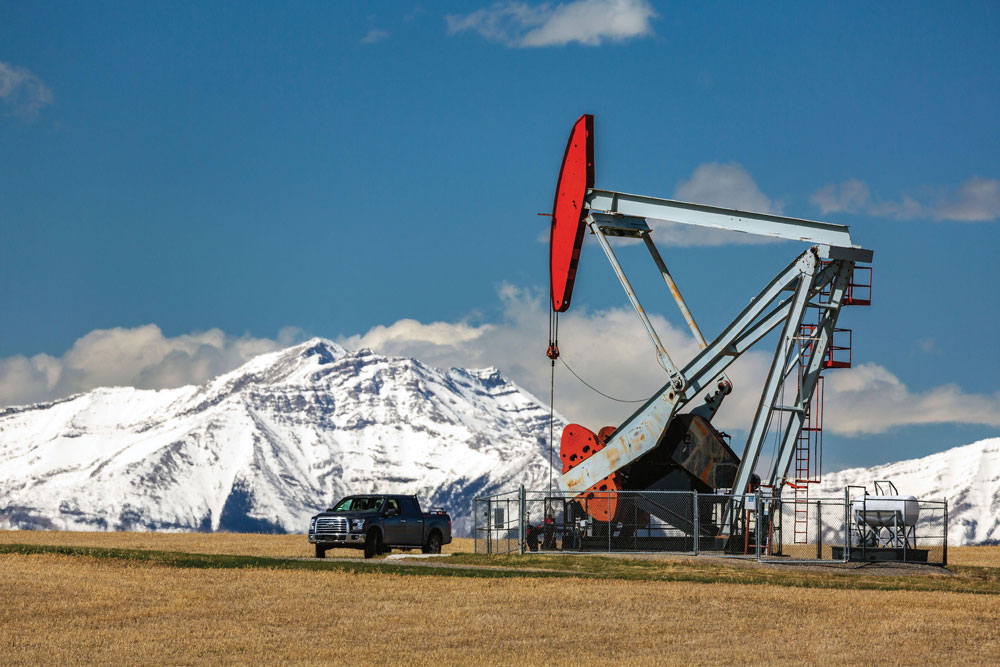
A “pristine” pumpjack near Longview, in the foothills of the Rockies, on the Cowboy Trail (Highway 22) south of Calgary.
Criticizing wind power during this disastrous era of climate change is like criticizing mom’s pumpkin pie. Calgary politicians have touted the fact that the CTrains run on wind power. But the electrons from wind-powered or gas-powered turbines flow through the same wire. Since urban residences and industry use most of the electricity, why not put the windmills closer to main consumers, thus cleverly reducing material expense and line loss of power over long transmission distances. Why not insist on solar panels on city rooftops, which is becoming the norm in Europe? Could it be that city folks might find such installations (especially wind turbines) not to their liking if they were forced to look at them day and night, while watching their electrical bills increase despite all the new infrastructure that comes with new power generation?
While two feuding entities, the Green Genie and Youseepee No-vax, are cudgelling their wits for a social media assault on yours truly, let us slip into a handy thicket of etymology. The word “pristine” derives from the Latin pristinus, meaning “former,” according to the Canadian Oxford Dictionary. Over time the meaning evolved from “ancient, primitive” to “1: in its original condition; 2: fresh and clean, as if new; and 3: unspoiled (pristine wilderness).”
We’re all familiar with current usages, as in “used F-150 in pristine condition,” “pristine bottled water,” “pristine starter-castle for the millionaire handyman”—whatever. None of these meanings apply to either the viewscape of the Rocky Mountains or the condition of its myriad peaks and river valleys. You may hike up to see the untouched marvels of Window Mountain Lake north of Coleman, for example, but don’t drink the water unless you are hankering for a dram of polycyclic aromatic compounds found in the coal dust blown into it from Teck Resources coal mines just across the Great Divide.
You could also argue, based on several factors, that there is no pristine wilderness to be had in these latitudes, let alone a pristine viewscape.
The view west of the windmills, as I write this, may not be pristine, but as the dwarf birch turns crimson and the aspen leaves go to yellow, the foothills and mountainsides are a watercolour artist’s dream, and that includes the battalions of round hay bales, the yellow fields of canola, the still-green grasslands topping high foothills and the distant ranch-houses and barns backed by the blue-grey walls of the mountain backdrop with endless cerulean skies above. There is a word for a view like this that stirs our heartsprings with love for our native place: sublime. Sublimity is what meets the eye when you leave the wind turbines behind.
As a young park warden in Jasper, I once endured a lecture by a Canadian Forest Service officer who liked clear-cut logging and summed it up: “I love to see the hand of man upon the land.” You can see the hand of man at work in the Alberta Forest Reserve just about anywhere you care to look. It’s there in the roads, in thousands of kilometres of seismic lines, in deeply eroded ATV trails, in clogged-up trout streams, logging clear-cuts and abandoned coal mines and slack piles. There are also pipeline rights-of-way, gas flare stacks and transmission lines criss-crossing and scarring the mountains. Even the tree cover today has greatly increased from what it was before European contact, the result of billions of dollars spent on wildfire control to preserve wood fibre for loggers, or in the case of national parks, to protect the scenery. That accounts for the massive fuel loads that feed today’s forest fires.
But in truth, the hand of man cannot be avoided. Even before European contact, the hand of man was at work doing cultural burning to improve the range for deer, elk and bison, to encourage food and medicinal plant growth and to keep some of the trees in check. Historical photos taken by the early surveyors in places like Waterton National Park show a less forested landscape far different from today—at least before the Kenow wildfire of 2017, that is.
Writing in the anthropology magazine Sapiens, Claudia Geib cites the work of geographer William Denevan, who speaks of the “pristine myth”—the belief that all of nature was once a sparsely populated wilderness where humans had little or no influence. She quotes Kawika Winter, an Indigenous biocultural ecologist at the University of Hawai‘i at Mānoa who says: “I loathe that word pristine. There have been no pristine systems on this planet for thousands of years.” Such scholars are part of a growing consensus against the old tenets of “fortress conservation”—the Eurocentric notion that “pristine wilderness” can only be protected by excluding human beings, particularly Indigenous people, from within its boundaries.
What we describe as a pristine viewscape is a kind of political mirage.
In Canada, First Nations people were pushed outside the boundaries of our national parks when the parks were founded. Recently Parks Canada has been striving to undo some of the harm by reaching out to Indigenous people and involving them in programs such as the reintroduction of bison into Banff National Park. That effort was marked in October 2024 by sponsoring a ceremonial bison hunt by members of the park’s Indigenous Advisory Council in which eight bison were to be “harvested” and used by First Nations members.
The Parks effort is a tentative move towards a conservation approach that includes humans as part of the landscape and biodiversity that ecologists are striving to protect. Danielle Smith, whose former claims to Cherokee ancestry qualify as “pretendian,” should stop pretending that coal mines and pipelines are somehow prettier to look at than windmills and solar panels. I doubt the public will be convinced by this petrostate gaslighting of pristine viewscapes, distorting the term “pristine” as a means of simply slowing the inevitable rise of renewables in favour of the fossil fuel lobby. It’s a fallacy that Alberta can have both unspoiled natural beauty and unchained industrial development at the same time in the same landscape—everybody going everywhere doing everything all the time.
The oil well access roads, gas wells and clear-cuts that scar Alberta’s east slope are not visible at a distance of 35 kilometres. In fact, what we describe as a pristine viewscape is a kind of political mirage. The concept that mountains are pristine landscapes is a myth. Yet the ranges of mountains on Alberta’s western horizon are sublimely beautiful. They still inspire awe, and I hope that someday, for all Albertans, they will inspire respect for the forests, the peaks and the rivers that lie behind that famous skyline.
Sid Marty is the inaugural winner of the Al and Eurithe Purdy Poetry Prize for Oldman’s River: New and Collected Poems (NeWest Press, 2023).
____________________________________________
Support independent local media. Please click to subscribe.
Read more from the archive “Where to Put a Solar Farm” November 2023.
The post Youseepee No-Vax vs. the Green Genie appeared first on Alberta Views.
1 Mar 2025 10:00:07
 Alberta Views
Alberta Views
Writing Ukraine
by Myrna KostashATHABASCA UNIVERSITY PRESS2024/$17.99/48 pp. Flipping through old diaries filled with youthful thoughts can be nerve-wracking. Yet acclaimed Alberta author Myrna Kostash took on an eve ...More ...
Flipping through old diaries filled with youthful thoughts can be nerve-wracking. Yet acclaimed Alberta author Myrna Kostash took on an even braver task. In Writing Ukraine, a long essay based on her writer-in-residence lecture at Athabasca University in 2022, Kostash revisits nearly five decades of writing and reflects on how her understanding of her Ukrainian heritage has evolved and matured over time.
She reserves her harshest criticism for All of Baba’s Children, the book that launched her career in 1977 as one of Canada’s leading non-fiction writers. Although a third-generation Ukrainian-Canadian, Kostash viewed herself as an outsider. To connect with her roots, she embarked on a cultural immersion journey, spending three months in Two Hills—a predominantly Ukrainian settlement at the time. She eavesdropped on café conversations, rummaged through dusty boxes and interviewed locals. “I passed judgment on it all,” she notes wryly, marvelling at the youthful audacity that defined her debut work.
After that book, Kostash made two trips to Ukraine—one before and one during Gorbachev’s perestroika. The quaint calendar images of thatched-roof cottages she had grown up seeing were replaced by the stark reality of village life. Her relatives lived without plumbing, with only one paved street, and exhaustion etched the faces of people waiting in line for the meagre goods available in shops. The brutality of Russian domination was painfully evident in signs that ordered Ukrainians to “speak human,” which meant speaking Russian. These trips also deepened her empathy for her family’s tumultuous past, shedding light on political views Kostash had once dismissed. She captured these revelations in her book Bloodlines: A Journey into Eastern Europe (1993).
As the essay unfolds, Kostash shows how her later works cast ever wider nets around her heritage. An inspiring church service she attends soon after the thaw of perestroika foreshadows Prodigal Daughter: A Journey to Byzantium (2010)—a travel diary exploring the roots of Ukrainian Orthodox traditions. In Canada, a visit to a mass grave of Indigenous warriors near Fort Battleford leads to her recent book, Ghosts in a Photograph (2022), in which she grapples with her settler family history and the colonial policies that secured their place on the land.
Ultimately Writing Ukraine paints a sweeping panorama of an author’s evolution. From this bird’s-eye view, Kostash’s reflections trace a gradual transformation: youthful certainty—what she often calls “swagger”—gives way to nuance, wisdom shaped by context, and a deep embrace of the multifaceted richness of the Ukrainian-Canadian experience.
Agnieszka Matejko is an artist and writer in Edmonton.
_______________________________________
Click here to sign up for our free online newsletter.
The post Writing Ukraine appeared first on Alberta Views.
1 Mar 2025 10:00:07
 Alberta Views
Alberta Views
An Astonishment of Stars
by Kirti BhadresaECW PRESS2024/$24.95/296 pp. In her debut short story collection, Kirti Bhadresa orients a wide range of stories around characters of South Asian descent, mostly women. These stories ...More ...
In her debut short story collection, Kirti Bhadresa orients a wide range of stories around characters of South Asian descent, mostly women. These stories deftly subvert immigrant cliches in their presentation of familial dynamics, food and cultural expectations, while not shying away from the sharp-edged realities of daily microaggressions, interracial (white-partnered) relationships, discrepancies in class and labour, and first-generation hustle. Cinematic in scope but intimate in each depiction, An Astonishment of Stars features among its protagonists a couple who moves from India to open a restaurant on the prairies and a mother who uses her white husband’s name to book a dinner reservation. With attentive care, Bhadresa traces the ordinariness of lives often made invisible.
In the more memorable stories, innocuous details evoke a story’s mood. “The Fundraiser” portrays the “pallid sausages” bought by a mother for a school fundraiser, despite the family not consuming meat. The title story, “An Astonishment of Stars,” constructs a family’s world around an abandoned airplane that creaks in the wind. Such vivid distillations serve as a core around which a story can pivot and stretch. At times I was reminded of Flannery O’Connor or Souvankham Thammavongsa—authors whose stories are taut with a thrumming tension. But too often in this collection, however, the narration feels detached, as if observing characters from a distance. When this narrative style is deployed in long stories, more suited to novella length and in which decades elapse, even lifetimes (“Backstage Passes,” “Lighten Up”), intriguing characters feel less dynamic than they could be and blend into fast-moving montages.
The strongest stories feel the closest to the characters they portray, landing in a specific scene and unspooling in crystalline moments made liminal and material. “Summer Camp” upends a coming-of-age experience, granting a long-suffering teenager sudden, dazzling agency. “Braids” tugs at the complexities of a kid on vacation with her father where she finds, to her burgeoning racial awareness, that she resembles the locals more than other tourists. The collection is at its best in a story such as “Invasion,” where a supple grace defines the writing and transports the reader into the life of a pregnant mother who is following her own mother’s recipe from deep intuition. Knitting together bodily awareness and glimpses of familial history, Bhadresa’s understated craft and keen gaze land here with confidence, and her ode to brown and South Asian women comes alive. Mothers and daughters, aunties, parents, neighbours and other forms of relation encounter one another and shine in the beauty of seeing and being seen.
Céline Chuang is a writer and bookseller in Edmonton
_______________________________________
Click here to sign up for our free online newsletter.
The post An Astonishment of Stars appeared first on Alberta Views.
1 Mar 2025 10:00:05

